





Microsoft Corp. is investigating reports that attackers are exploiting two previously unknown vulnerabilities in Exchange Server, a technology many organizations rely on to send and receive email. Microsoft says it is expediting work on software patches to plug the security holes. In the meantime, it is urging a subset of Exchange customers to enable a setting that could help mitigate ongoing attacks.

In customer guidance released Thursday, Microsoft said it is investigating two reported zero-day flaws affecting Microsoft Exchange Server 2013, 2016, and 2019. CVE-2022-41040, is a Server-Side Request Forgery (SSRF) vulnerability that can enable an authenticated attacker to remotely trigger the second zero-day vulnerability — CVE-2022-41082 — which allows remote code execution (RCE) when PowerShell is accessible to the attacker.
Microsoft said Exchange Online has detections and mitigation in place to protect customers. Customers using on-premises Microsoft Exchange servers are urged to review the mitigations suggested in the security advisory, which Microsoft says should block the known attack patterns.
Vietnamese security firm GTSC on Thursday published a writeup on the two Exchange zero-day flaws, saying it first observed the attacks in early August being used to drop “webshells.” These web-based backdoors offer attackers an easy-to-use, password-protected hacking tool that can be accessed over the Internet from any browser.
“We detected webshells, mostly obfuscated, being dropped to Exchange servers,” GTSC wrote. “Using the user-agent, we detected that the attacker uses Antsword, an active Chinese-based opensource cross-platform website administration tool that supports webshell management. We suspect that these come from a Chinese attack group because the webshell codepage is 936, which is a Microsoft character encoding for simplified Chinese.”
GTSC’s advisory includes details about post-compromise activity and related malware, as well as steps it took to help customers respond to active compromises of their Exchange Server environment. But the company said it would withhold more technical details of the vulnerabilities for now.
In March 2021, hundreds of thousands of organizations worldwide had their email stolen and multiple backdoor webshells installed, all thanks to four zero-day vulnerabilities in Exchange Server.
Granted, the zero-day flaws that powered that debacle were far more critical than the two detailed this week, and there are no signs yet that exploit code has been publicly released (that will likely change soon). But part of what made last year’s Exchange Server mass hack so pervasive was that vulnerable organizations had little or no advance notice on what to look for before their Exchange Server environments were completely owned by multiple attackers.
Microsoft is quick to point out that these zero-day flaws require an attacker to have a valid username and password for an Exchange user, but this may not be such a tall order for the hackers behind these latest exploits against Exchange Server.
Steven Adair is president of Volexity, the Virginia-based cybersecurity firm that was among the first to sound the alarm about the Exchange zero-days targeted in the 2021 mass hack. Adair said GTSC’s writeup includes an Internet address used by the attackers that Volexity has tied with high confidence to a China-based hacking group that has recently been observed phishing Exchange users for their credentials.
In February 2022, Volexity warned that this same Chinese hacking group was behind the mass exploitation of a zero-day vulnerability in the Zimbra Collaboration Suite, which is a competitor to Microsoft Exchange that many enterprises use to manage email and other forms of messaging.
If your organization runs Exchange Server, please consider reviewing the Microsoft mitigations and the GTSC post-mortem on their investigations.
Someone has recently created a large number of fake LinkedIn profiles for Chief Information Security Officer (CISO) roles at some of the world’s largest corporations. It’s not clear who’s behind this network of fake CISOs or what their intentions may be. But the fabricated LinkedIn identities are confusing search engine results for CISO roles at major companies, and they are being indexed as gospel by various downstream data-scraping sources.
If one searches LinkedIn for the CISO of the energy giant Chevron, one might find the profile for a Victor Sites, who says he’s from Westerville, Ohio and is a graduate of Texas A&M University.
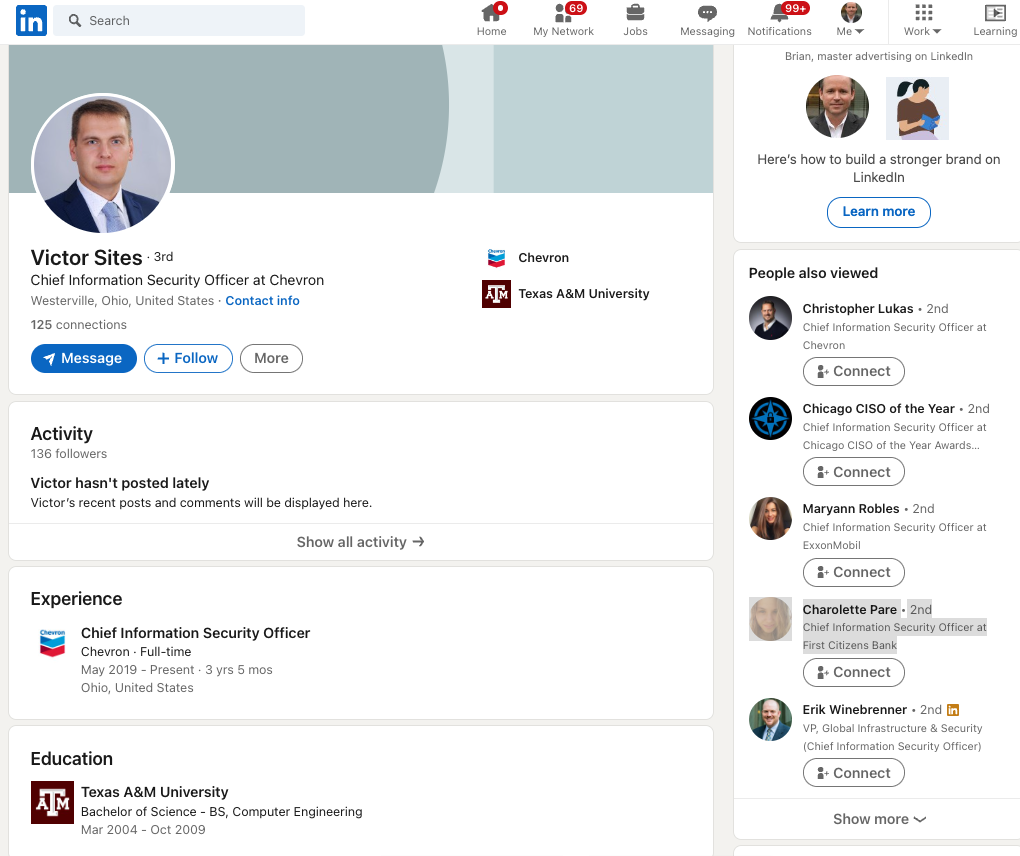
The LinkedIn profile for Victor Sites, who is most certainly NOT the CISO of Chevron.
Of course, Sites is not the real CISO of Chevron. That role is currently occupied by Christopher Lukas of Danville, Calif. If you were confused at this point, you might ask Google who it thinks is the current Chief Information Security Officer of Chevron. When KrebsOnSecurity did that earlier this morning, the fake CISO profile was the very first search result returned (followed by the LinkedIn profile for the real Chevron CISO).
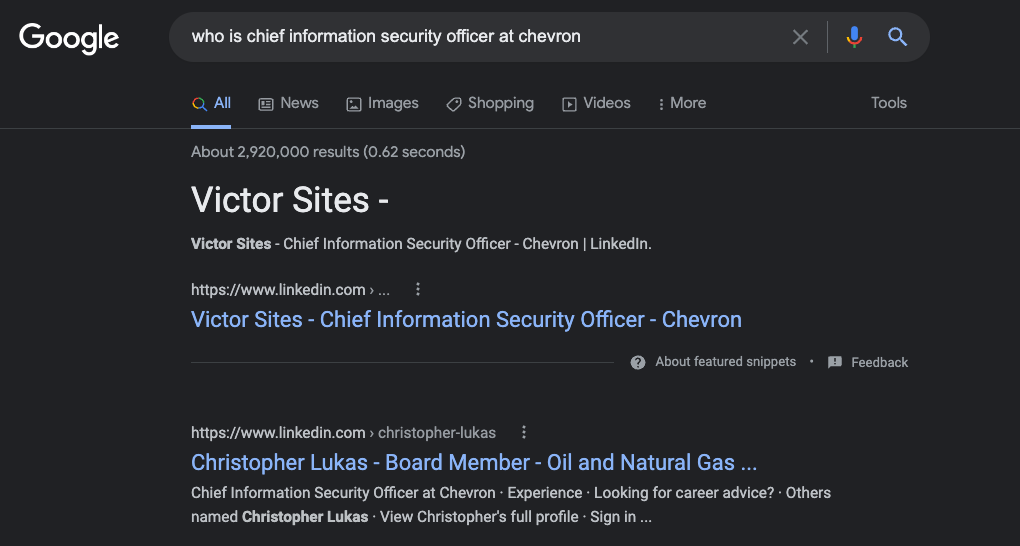
Helpfully, LinkedIn seems to be able to detect something in common about all these fake CISO profiles, because it suggested I view a number of them in the “People Also Viewed” column seen in the image above. There are two fake CISO profiles suggested there, including one for a Maryann Robles, who claims to be the CISO of another energy giant — ExxonMobil.
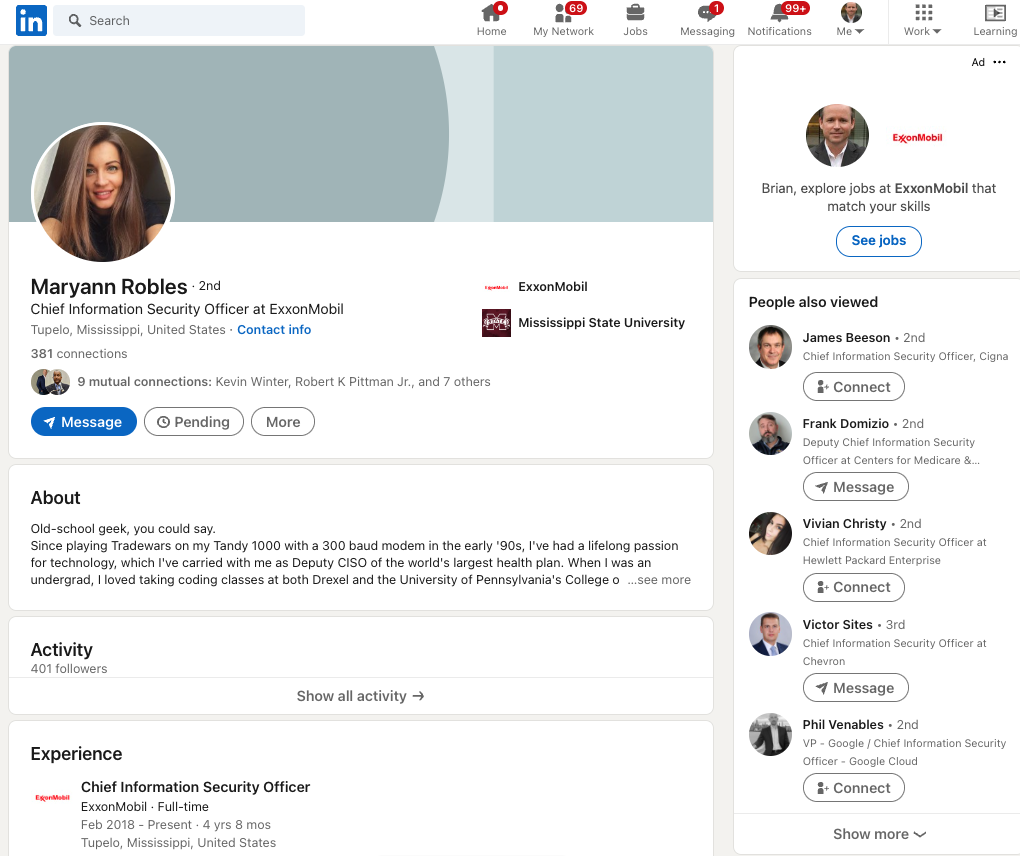
Maryann’s profile says she’s from Tupelo, Miss., and includes this detail about how she became a self-described “old-school geek.”
“Since playing Tradewars on my Tandy 1000 with a 300 baud modem in the early ’90s, I’ve had a lifelong passion for technology, which I’ve carried with me as Deputy CISO of the world’s largest health plan,” her profile reads.
However, this description appears to have been lifted from the profile for the real CISO at the Centers for Medicare & Medicaid Services in Baltimore, Md.
Interestingly, Maryann’s LinkedIn profile was accepted as truth by Cybercrime Magazine’s CISO 500 listing, which claims to maintain a list of the current CISOs at America’s largest companies:
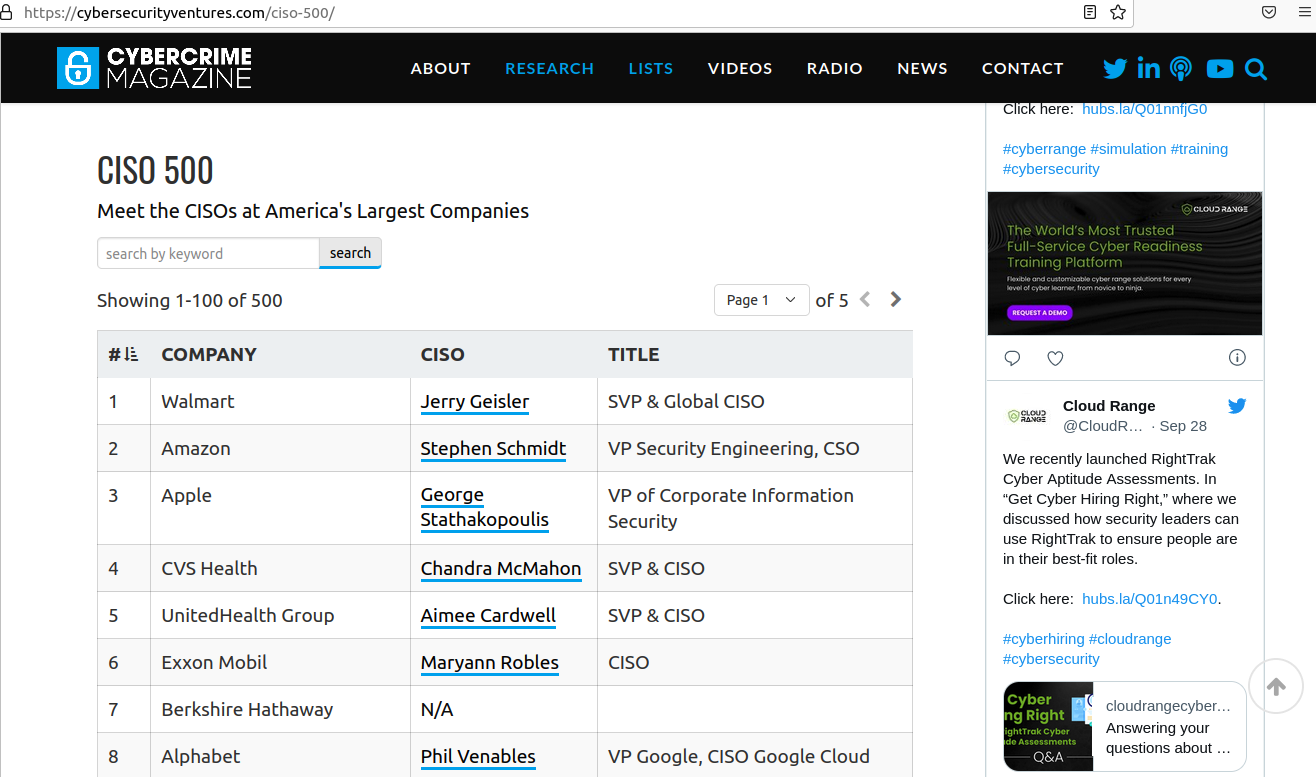
The fake CISO for ExxOnMobil was indexed in Cybercrime Magazine’s CISO 500.
Rich Mason, the former CISO at Fortune 500 firm Honeywell, began warning his colleagues on LinkedIn about the phony profiles earlier this week.
“It’s interesting the downstream sources that repeat LinkedIn bogus content as truth,” Mason said. “This is dangerous, Apollo.io, Signalhire, and Cybersecurity Ventures.”
Google wasn’t fooled by the phony LinkedIn profile for Jennie Biller, who claims to be CISO at biotechnology giant Biogen (the real Biogen CISO is Russell Koste). But Biller’s profile is worth mentioning because it shows how some of these phony profiles appear to be quite hastily assembled. Case in point: Biller’s name and profile photo suggest she is female, however the “About” description of her accomplishments uses male pronouns. Also, it might help that Jennie only has 18 connections on LinkedIn.
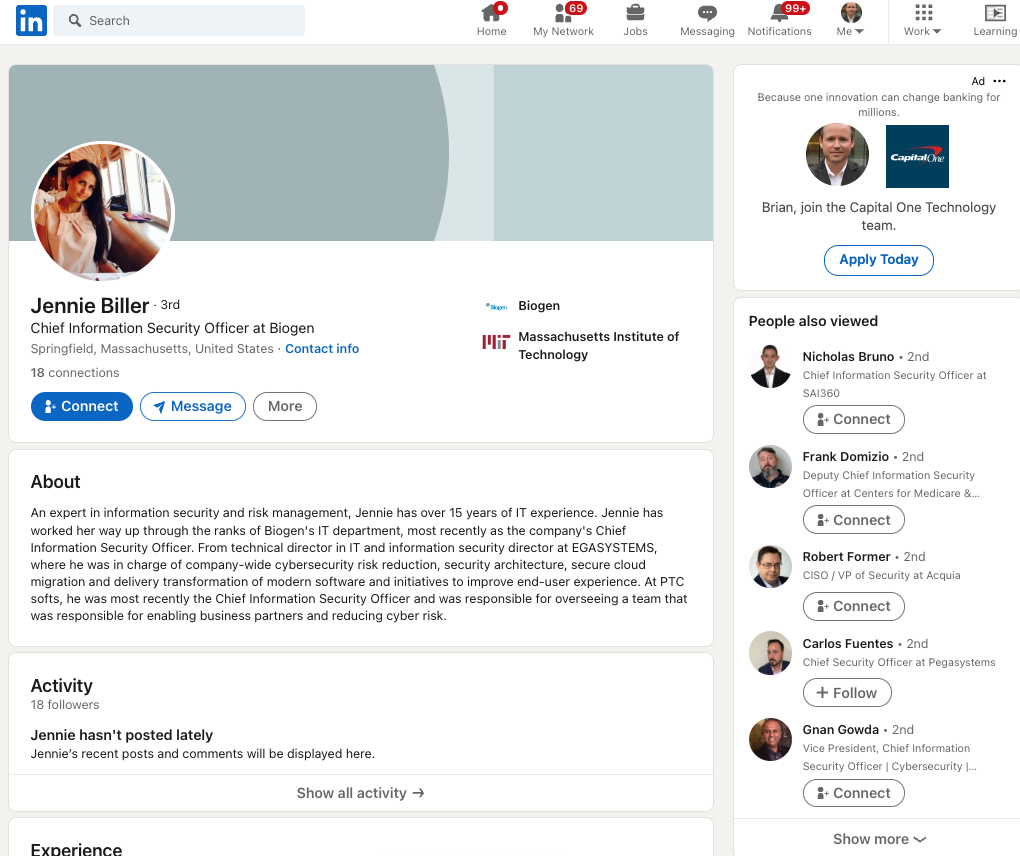
Again, we don’t know much about who or what is behind these profiles, but in August the security firm Mandiant (recently acquired by Google) told Bloomberg that hackers working for the North Korean government have been copying resumes and profiles from leading job listing platforms LinkedIn and Indeed, as part of an elaborate scheme to land jobs at cryptocurrency firms.
None of the profiles listed here responded to requests for comment (or to become a connection).
In a statement provided to KrebsOnSecurity, LinkedIn said its teams were actively working to take these fake accounts down.
“We do have strong human and automated systems in place, and we’re continually improving, as fake account activity becomes more sophisticated,” the statement reads. “In our transparency report we share how our teams plus automated systems are stopping the vast majority of fraudulent activity we detect in our community – around 96% of fake accounts and around 99.1% of spam and scam.”
LinkedIn could take one simple step that would make it far easier for people to make informed decisions about whether to trust a given profile: Add a “created on” date for every profile. Twitter does this, and it’s enormously helpful for filtering out a great deal of noise and unwanted communications.
The former CISO Mason said LinkedIn also could experiment with offering something akin to Twitter’s verified mark to users who chose to validate that they can respond to email at the domain associated with their stated current employer.
“If I saw that a LinkedIn profile had been domain-validated, then my confidence in that profile would go way up,” Mason said, noting that many of the fake profiles had hundreds of followers, including dozens of real CISOs. Maryann’s profile grew by a hundred connections in just the past few days, he said.
“If we have CISOs that are falling for this, what hopes do the masses have?” Mason said.
Mason said LinkedIn also needs a more streamlined process for allowing employers to remove phony employee accounts. He recently tried to get a phony profile removed from LinkedIn for someone who falsely claimed to have worked for his company.
“I shot a note to LinkedIn and said please remove this, and they said, well, we have to contact that person and arbitrate this,” he said. “They gave the guy two weeks and he didn’t respond, so they took it down. But that doesn’t scale, and there needs to be a mechanism where an employer can contact LinkedIn and have these fake profiles taken down in less than two weeks.”



A 36-year-old Russian man recently identified by KrebsOnSecurity as the likely proprietor of the massive RSOCKS botnet has been arrested in Bulgaria at the request of U.S. authorities. At a court hearing in Bulgaria this month, the accused hacker requested and was granted extradition to the United States, reportedly telling the judge, “America is looking for me because I have enormous information and they need it.”

A copy of the passport for Denis Kloster, as posted to his Vkontakte page in 2019.
On June 22, KrebsOnSecurity published Meet the Administrators of the RSOCKS Proxy Botnet, which identified Denis Kloster, a.k.a. Denis Emelyantsev, as the apparent owner of RSOCKS, a collection of millions of hacked devices that were sold as “proxies” to cybercriminals looking for ways to route their malicious traffic through someone else’s computer.
A native of Omsk, Russia, Kloster came into focus after KrebsOnSecurity followed clues from the RSOCKS botnet master’s identity on the cybercrime forums to Kloster’s personal blog, which featured musings on the challenges of running a company that sells “security and anonymity services to customers around the world.” Kloster’s blog even included a group photo of RSOCKS employees.
“Thanks to you, we are now developing in the field of information security and anonymity!,” Kloster’s blog enthused. “We make products that are used by thousands of people around the world, and this is very cool! And this is just the beginning!!! We don’t just work together and we’re not just friends, we’re Family.”
The Bulgarian news outlet 24Chasa.bg reports that Kloster was arrested in June at a co-working space in the southwestern ski resort town of Bansko, and that the accused asked to be handed over to the American authorities.
“I have hired a lawyer there and I want you to send me as quickly as possible to clear these baseless charges,” Kloster reportedly told the Bulgarian court this week. “I am not a criminal and I will prove it in an American court.”
Launched in 2013, RSOCKS was shut down in June 2022 as part of an international investigation into the cybercrime service. According to the Justice Department, the RSOCKS botnet initially targeted Internet of Things (IoT) devices, including industrial control systems, time clocks, routers, audio/video streaming devices, and smart garage door openers; later in its existence, the RSOCKS botnet expanded into compromising additional types of devices, including Android devices and conventional computers, the DOJ said.
The Justice Department’s June 2022 statement about that takedown cited a search warrant from the U.S. Attorney’s Office for the Southern District of California, which also was named by Bulgarian news outlets this month as the source of Kloster’s arrest warrant.
When asked about the existence of an arrest warrant or criminal charges against Kloster, a spokesperson for the Southern District said, “no comment.”
Update, Sept. 24, 9:00 a.m. ET: Kloster was named in a 2019 indictment (PDF) unsealed Sept. 23 by the Southern District court.

The employees who kept things running for RSOCKS, circa 2016. Notice that nobody seems to be wearing shoes.
24Chasa said the defendant’s surname is Emelyantsev and that he only recently adopted the last name Kloster, which is his mother’s maiden name.
As KrebsOnSecurity reported in June, Kloster also appears to be a major player in the Russian email spam industry. In several private exchanges on cybercrime forums, the RSOCKS administrator claimed ownership of the RUSdot spam forum. RUSdot is the successor forum to Spamdot, a far more secretive and restricted forum where most of the world’s top spammers, virus writers and cybercriminals collaborated for years before the community’s implosion in 2010.
Email spam — and in particular malicious email sent via compromised computers — is still one of the biggest sources of malware infections that lead to data breaches and ransomware attacks. So it stands to reason that as administrator of Russia’s most well-known forum for spammers, the defendant in this case probably knows quite a bit about other top players in the botnet spam and malware community.
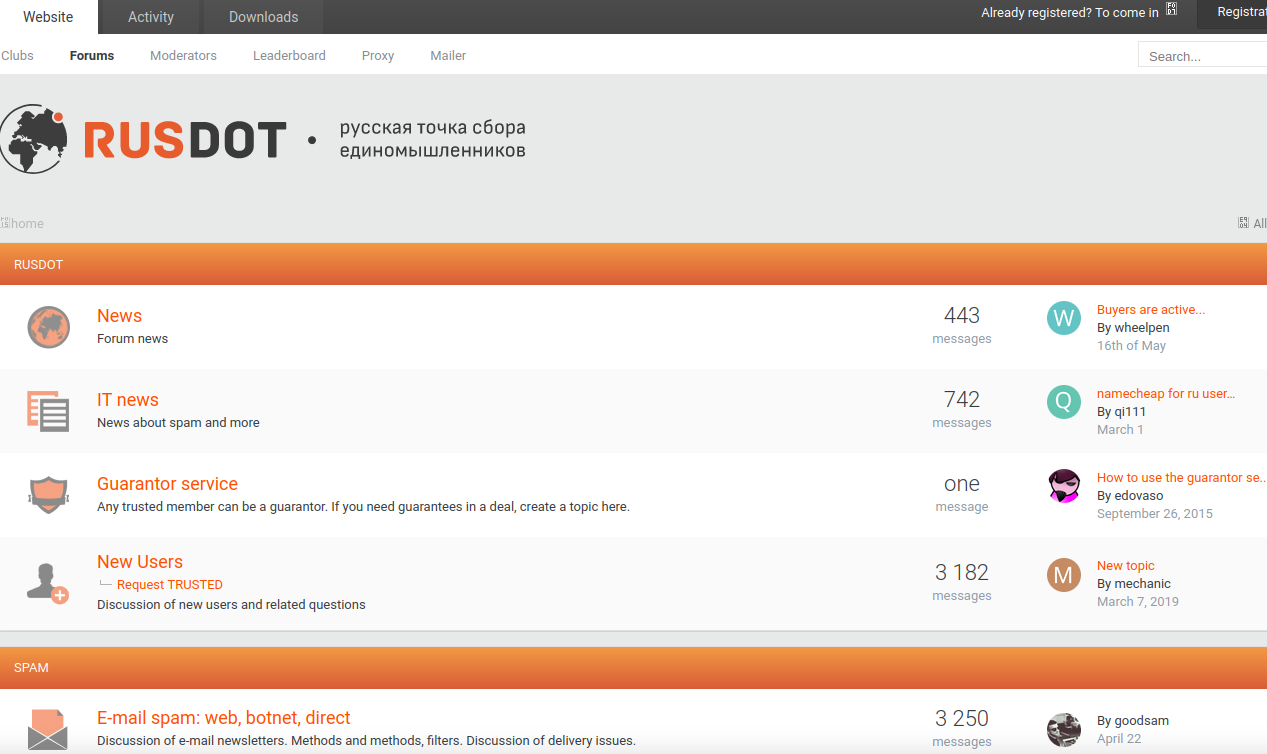
A Google-translated version of the Rusdot spam forum.
Despite maintaining his innocence, Kloster reportedly told the Bulgarian judge that he could be useful to American investigators.
“America is looking for me because I have enormous information and they need it,” Kloster told the court, according to 24Chasa. “That’s why they want me.”
The Bulgarian court agreed, and granted his extradition. Kloster’s fiancee also attended the extradition hearing, and reportedly wept in the hall outside the entire time.
Kloster turned 36 while awaiting his extradition hearing, and may soon be facing charges that carry punishments of up to 20 years in prison.



This month’s Patch Tuesday offers a little something for everyone, including security updates for a zero-day flaw in Microsoft Windows that is under active attack, and another Windows weakness experts say could be used to power a fast-spreading computer worm. Also, Apple has also quashed a pair of zero-day bugs affecting certain macOS and iOS users, and released iOS 16, which offers a new privacy and security feature called “Lockdown Mode.” And Adobe axed 63 vulnerabilities in a range of products.

Microsoft today released software patches to plug at least 64 security holes in Windows and related products. Worst in terms of outright scariness is CVE-2022-37969, which is a “privilege escalation” weakness in the Windows Common Log File System Driver that allows attackers to gain SYSTEM-level privileges on a vulnerable host. Microsoft says this flaw is already being exploited in the wild.
Kevin Breen, director of cyber threat research at Immersive Labs, said any vulnerability that is actively targeted by attackers in the wild must be put to the top of any patching list.
“Not to be fooled by its relatively low CVSS score of 7.8, privilege escalation vulnerabilities are often highly sought after by cyber attackers,” Breen said. “Once an attacker has managed to gain a foothold on a victim’s system, one of their first actions will be to gain a higher level of permissions, allowing the attacker to disable security applications and any device monitoring. There is no known workaround to date, so patching is the only effective mitigation.”
Satnam Narang at Tenable said CVE-2022-24521 — a similar vulnerability in the same Windows log file component — was patched earlier this year as part of Microsoft’s April Patch Tuesday release and was also exploited in the wild.
“CVE-2022-37969 was disclosed by several groups, though it’s unclear if CVE-2022-37969 is a patch-bypass for CVE-2022-24521 at this point,” Narang said.
Another vulnerability Microsoft patched this month — CVE-2022-35803 — also seems to be related to the same Windows log file component. While there are no indications CVE-2022-35803 is being actively exploited, Microsoft suggests that exploitation of this flaw is more likely than not.
Trend Micro’s Dustin Childs called attention to CVE-2022-34718, a remote code execution flaw in the Windows TCP/IP service that could allow an unauthenticated attacker to execute code with elevated privileges on affected systems without user interaction.
“That officially puts it into the ‘wormable’ category and earns it a CVSS rating of 9.8,” Childs said. “However, only systems with IPv6 enabled and IPSec configured are vulnerable. While good news for some, if you’re using IPv6 (as many are), you’re probably running IPSec as well. Definitely test and deploy this update quickly.”
Cisco Talos warns about four critical vulnerabilities fixed this month — CVE-2022-34721 and CVE-2022-34722 — which have severity scores of 9.8, though they are “less likely” to be exploited, according to Microsoft.
“These are remote code execution vulnerabilities in the Windows Internet Key Exchange protocol that could be triggered if an attacker sends a specially crafted IP packet,” wrote Jon Munshaw and Asheer Malhotra. “Two other critical vulnerabilities, CVE-2022-35805 and CVE-2022-34700 exist in on-premises instances of Microsoft Dynamics 365. An authenticated attacker could exploit these vulnerabilities to run a specially crafted trusted solution package and execute arbitrary SQL commands. The attacker could escalate their privileges further and execute commands as the database owner.”
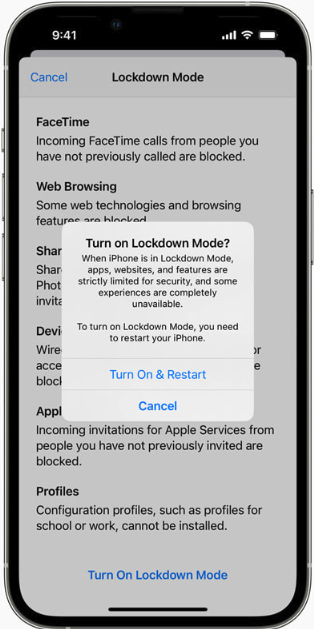 Not to be outdone, Apple fixed at least two zero-day vulnerabilities when it released updates for iOS, iPadOS, macOS and Safari. CVE-2022-32984 is a problem in the deepest recesses of the operating system (the kernel). Apple pushed an emergency update for a related zero-day last month in CVE-2022-32983, which could be used to foist malware on iPhones, iPads and Macs that visited a booby-trapped website.
Not to be outdone, Apple fixed at least two zero-day vulnerabilities when it released updates for iOS, iPadOS, macOS and Safari. CVE-2022-32984 is a problem in the deepest recesses of the operating system (the kernel). Apple pushed an emergency update for a related zero-day last month in CVE-2022-32983, which could be used to foist malware on iPhones, iPads and Macs that visited a booby-trapped website.
Also listed under active attack is CVE-2022-32817, which has been fixed on macOS 12.6 (Monterey), macOS 11.7 (Big Sur), iOS 15.7 and iPadOS 15.7, and iOS 16. The same vulnerability was fixed in Apple Watch in July 2022, and credits Xinru Chi of Japanese cybersecurity firm Pangu Lab.
“Interestingly, this CVE is also listed in the advisory for iOS 16, but it is not called out as being under active exploit for that flavor of the OS,” Trend Micro’s Childs noted. “Apple does state in its iOS 16 advisory that ‘Additional CVE entries to be added soon.’ It’s possible other bugs could also impact this version of the OS. Either way, it’s time to update your Apple devices.”
Apple’s iOS 16 includes two new security and privacy features — Lockdown Mode and Safety Check. Wired.com describes Safety Check as a feature for users who are at risk for, or currently experiencing, domestic abuse.
“The tool centralizes a number of controls in one place to make it easier for users to manage and revoke access to their location data and reset privacy-related permissions,” wrote Lily Hay Newman.
“Lockdown Mode, on the other hand, is meant for users who potentially face targeted spyware attacks and aggressive state-backed hacking. The feature comprehensively restricts any nonessential iOS features so there are as few potential points of entry to a device as possible. As more governments and repressive entities around the world have begun purchasing powerful commodity spyware to target individuals of particular importance or interest, iOS’s general security defenses haven’t been able to keep pace with these specialized threats.”
To turn on Lockdown Mode in iOS 16, go to Settings, then Privacy and Security, then Lockdown Mode. Safety Check is located in the same area.
Finally, Adobe released seven patches addressing 63 security holes in Adobe Experience Manager, Bridge, InDesign, Photoshop, InCopy, Animate, and Illustrator. More on those updates is here.
Don’t forget to back up your data and/or system before applying any security updates. If you experience glitches or problems installing any of these patches this month, please consider leaving a comment about it below; there’s a decent chance other readers have experienced the same and may chime in here with useful tips.



A 21-year-old New Jersey man has been arrested and charged with stalking in connection with a federal investigation into groups of cybercriminals who are settling scores by hiring people to carry out physical attacks on their rivals. Prosecutors say the defendant recently participated in several of these schemes — including firing a handgun into a Pennsylvania home and torching a residence in another part of the state with a Molotov Cocktail.
Patrick McGovern-Allen of Egg Harbor Township, N.J. was arrested on Aug. 12 on a warrant from the U.S. Federal Bureau of Investigation. An FBI complaint alleges McGovern-Allen was part of a group of co-conspirators who are at the forefront of a dangerous escalation in coercion and intimidation tactics increasingly used by competing cybercriminal groups.
Prosecutors say that around 2 a.m. on Jan 2, 2022, McGovern-Allen and an unidentified co-conspirator fired multiple handgun rounds into a residence in West Chester, Pa. Fortunately, none of the residents inside the home at the time were injured. But prosecutors say the assailants actually recorded video of the attack as “proof” that the shooting had been carried out.
A copy of that video was obtained by KrebsOnSecurity. According to investigators, McGovern-Allen was one of the shooters, who yelled “Justin Active was here” as they haphazardly fired at least eight rounds into the lower story of the West Chester residence.
On Dec. 18, 2021, police in Abington Township, Pa., responded to reports of a house fire from homeowners who said it sounded like something was thrown at their residence just prior to the fire.
Weeks later, on the day of the shooting in West Chester, a detective with the Westtown East Goshen Police Department contacted the Abington police and shared another video that was circulating on several online message boards that appeared to show two individuals setting fire to the Abington Township residence. The criminal complaint said the two police officers agreed the same suspect was present in both videos.
A copy of that video also was obtained by KrebsOnSecurity, and it shows at least two individuals smashing a window, then lighting a rag-soaked Mad Dog 20/20 grape wine bottle and hurling it at the side of the home [Update: My apologies for the file download link, but YouTube just deleted both of the videos included in this story — for allegedly violating their community standards].
“The Molotov cocktail caused the immediate surrounding area to ignite, including the siding of the house, grass, and the wooden chair,” the government’s complaint against McGovern-Allen states. “The two suspects then fled on foot toward the street and begin yelling something when the video stops.”
The government mentions the victims only by their initials — “K.M.” in the shooting and “A.R.” in the firebombing — but said both had been the target of previous harassment by rival cybercriminal groups that included swatting attacks, wherein the perpetrators spoof a distress call to the police about a hostage situation, suicide or bomb threat with the goal of sending a heavily-armed police response to a targeted address.
A number of previous swatting incidents have turned deadly. But these more “hands-on” and first person attacks are becoming increasingly common within certain cybercriminal communities, particularly those engaged in SIM swapping, a crime in which identity thieves hijack a target’s mobile phone number and use that to wrest control over the victim’s various online accounts and identities.
The complaint mentions a handle and user ID allegedly used by McGovern-Allen’s online persona “Tongue” on the Discord chat service, (user: “Tongue#0001”).
“In the chats, [Tongue] tells other Discord users that he was the person who shot K.M.’s house and that he was willing to commit firebombings using Molotov Cocktails,” the complaint alleges. “For example, in one Discord chat from March 2022, [the defendant] states ‘if you need anything done for $ lmk [“let me know”]/I did a shooting/Molotov/but I can also do things for ur entertainment.”
KrebsOnsecurity reviewed hundreds of chat records tied to this Tongue alias, and it appears both attacks were motivated by a desire to get back at a rival cybercriminal by attacking the female friends of that rival.
Recall that the shooters in the West Chester, Pa. incident shouted “Justin Active was here.” Justin Active is the nickname of an individual who is just as active in the same cybercriminal channels, but who has vehemently denied knowledge of or participation in the shooting. Justin Active said on Telegram that the person targeted in the shooting was his ex-girlfriend, and that the firebombing targeted another friend of his.
Justin Active has claimed for months that McGovern-Allen was responsible for both attacks, saying they were intended as an intimidation tactic against him. “DO THE PATRICK MCGOVERN ALLEN RAID DANCE!,” Justin Active’s alias “Nutcase68” shouted on Telegram on Aug. 12, the same day McGovern-Allen was arrested by authorities.
Justin Active’s version of events seems to be supported by a reference in the criminal complaint to an April 2, 2022 chat in which Tongue explained the reason for the shooting.
“The video/is [K]’s house/getting shit/shot/justin active/ was her current bf/ the reason it happened,” Tongue explained. “So that’s why Justin active was there.”
The Telegram chat channels that Justin Active and Tongue both frequented have hundreds to thousands of members each, and some of the more interesting solicitations on these communities are job offers for in-person assignments and tasks that can be found if one searches for posts titled, “If you live near,” or “IRL job” — short for “in real life” job.
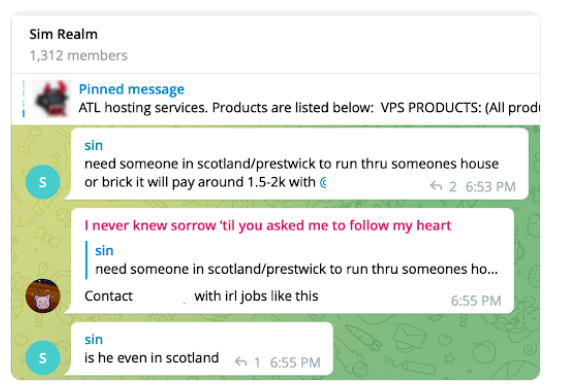
A number of these classified ads are in service of performing “brickings,” where someone is hired to visit a specific address and toss a brick through the target’s window.
“If you live near Edmonton Canada dm me need someone bricked,” reads on Telegram message on May 31, 2022.
“If you live near [address redacted] Lakewood, CA, dm [redacted] Paying 3k to slash the tires,” reads another help wanted ad in the same channel on Feb. 24, 2022. “If you live near here and can brick them, dm [address omitted] Richland, WA,” reads another from that same day.

McGovern-Allen was in the news not long ago. According to a Sept. 2020 story from The Press of Atlantic City, a then 19-year-old Patrick McGovern Allen was injured after driving into a building and forcing residents from their home.
“Police found a 2007 Lexus, driven by Patrick McGovern-Allen, 19, that had lost control and left the road, crashing into the eastern end of the 1600 building,” the story recounted. “The car was driven through the steps that provide access to the second-floor apartments, destroying them, and also caused damage to the outer wall.”

A search on the Inmate Locator of the U.S. Bureau of Prisons website shows that McGovern-Allen remains in federal custody at a detention facility in Philadelphia. He’s currently represented by a public defender who has not responded to requests for comment.
A copy of the criminal complaint against McGovern-Allen is available here (PDF).
Many of the individuals involved in paying others to commit these physical attacks are also frequent participants in several Telegram channels focused singularly on SIM swapping activity. As a result, the vast majority of the people being targeted for brickings and other real-life physical assaults tend to be other cybercriminals involved in SIM swapping crimes (or individuals on the periphery of that scene).
There are dozens of SIM swappers who are now teenage or 20-something millionaires, by virtue of having stolen vast sums of cryptocurrencies from SIM swapping victims. And now many of these same individuals are finding that communities like Telegram can be leveraged to hire physical harassment and intimidation of their rivals and competitors.
The primary barrier to hiring someone to brick a home or slash some tires seems to be the costs involved: A number of solicitations for these services advertised payment of $3,000 or more upon proof of successful completion, which usually involves recording the attack and hiring a getaway driver in the town where the crime is to take place (calling a cab or hailing an Uber from the scene of a bricking isn’t the brightest idea).
My fear is these violence-as-a-service offerings will at some point migrate outside of the SIM swapping communities. This is precisely what happened with swatting, which for years was a crime perpetrated almost exclusively against online gamers and people streaming their games online. These days, swatting attacks are commonly used by SIM swapping groups as a way to harass and extort regular Internet users into giving up prized social media account names that can be resold for thousands of dollars.




Phishers are enjoying remarkable success using text messages to steal remote access credentials and one-time passcodes from employees at some of the world’s largest technology companies and customer support firms. A recent spate of SMS phishing attacks from one cybercriminal group has spawned a flurry of breach disclosures from affected companies, which are all struggling to combat the same lingering security threat: The ability of scammers to interact directly with employees through their mobile devices.

In mid-June 2022, a flood of SMS phishing messages began targeting employees at commercial staffing firms that provide customer support and outsourcing to thousands of companies. The missives asked users to click a link and log in at a phishing page that mimicked their employer’s Okta authentication page. Those who submitted credentials were then prompted to provide the one-time password needed for multi-factor authentication.
The phishers behind this scheme used newly-registered domains that often included the name of the target company, and sent text messages urging employees to click on links to these domains to view information about a pending change in their work schedule.
The phishing sites leveraged a Telegram instant message bot to forward any submitted credentials in real-time, allowing the attackers to use the phished username, password and one-time code to log in as that employee at the real employer website. But because of the way the bot was configured, it was possible for security researchers to capture the information being sent by victims to the public Telegram server.
This data trove was first reported by security researchers at Singapore-based Group-IB, which dubbed the campaign “0ktapus” for the attackers targeting organizations using identity management tools from Okta.com.
“This case is of interest because despite using low-skill methods it was able to compromise a large number of well-known organizations,” Group-IB wrote. “Furthermore, once the attackers compromised an organization they were quickly able to pivot and launch subsequent supply chain attacks, indicating that the attack was planned carefully in advance.”
It’s not clear how many of these phishing text messages were sent out, but the Telegram bot data reviewed by KrebsOnSecurity shows they generated nearly 10,000 replies over approximately two months of sporadic SMS phishing attacks targeting more than a hundred companies.
A great many responses came from those who were apparently wise to the scheme, as evidenced by the hundreds of hostile replies that included profanity or insults aimed at the phishers: The very first reply recorded in the Telegram bot data came from one such employee, who responded with the username “havefuninjail.”
Still, thousands replied with what appear to be legitimate credentials — many of them including one-time codes needed for multi-factor authentication. On July 20, the attackers turned their sights on internet infrastructure giant Cloudflare.com, and the intercepted credentials show at least three employees fell for the scam.
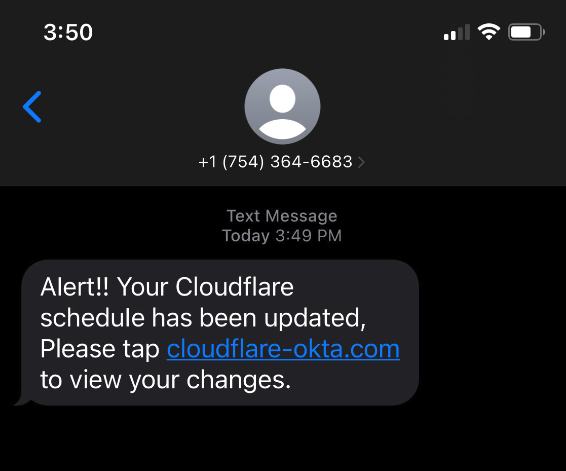
Image: Cloudflare.com
In a blog post earlier this month, Cloudflare said it detected the account takeovers and that no Cloudflare systems were compromised. Cloudflare said it does not rely on one-time passcodes as a second factor, so there was nothing to provide to the attackers. But Cloudflare said it wanted to call attention to the phishing attacks because they would probably work against most other companies.
“This was a sophisticated attack targeting employees and systems in such a way that we believe most organizations would be likely to be breached,” Cloudflare CEO Matthew Prince wrote. “On July 20, 2022, the Cloudflare Security team received reports of employees receiving legitimate-looking text messages pointing to what appeared to be a Cloudflare Okta login page. The messages began at 2022-07-20 22:50 UTC. Over the course of less than 1 minute, at least 76 employees received text messages on their personal and work phones. Some messages were also sent to the employees family members.”
On three separate occasions, the phishers targeted employees at Twilio.com, a San Francisco based company that provides services for making and receiving text messages and phone calls. It’s unclear how many Twilio employees received the SMS phishes, but the data suggest at least four Twilio employees responded to a spate of SMS phishing attempts on July 27, Aug. 2, and Aug. 7.
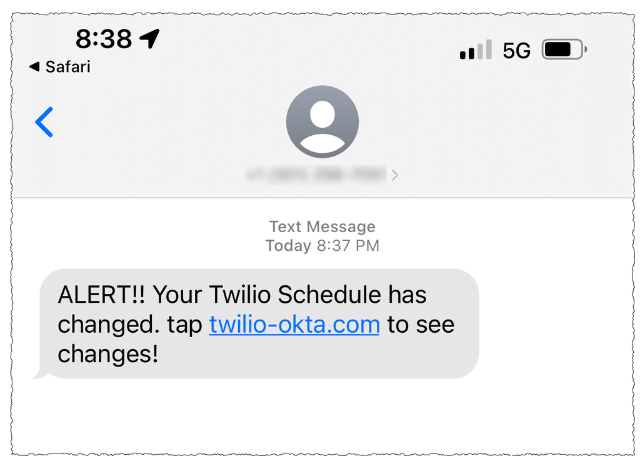
On that last date, Twilio disclosed that on Aug. 4 it became aware of unauthorized access to information related to a limited number of Twilio customer accounts through a sophisticated social engineering attack designed to steal employee credentials.
“This broad based attack against our employee base succeeded in fooling some employees into providing their credentials,” Twilio said. “The attackers then used the stolen credentials to gain access to some of our internal systems, where they were able to access certain customer data.”
That “certain customer data” included information on roughly 1,900 users of the secure messaging app Signal, which relied on Twilio to provide phone number verification services. In its disclosure on the incident, Signal said that with their access to Twilio’s internal tools the attackers were able to re-register those users’ phone numbers to another device.
On Aug. 25, food delivery service DoorDash disclosed that a “sophisticated phishing attack” on a third-party vendor allowed attackers to gain access to some of DoorDash’s internal company tools. DoorDash said intruders stole information on a “small percentage” of users that have since been notified. TechCrunch reported last week that the incident was linked to the same phishing campaign that targeted Twilio.
This phishing gang apparently had great success targeting employees of all the major mobile wireless providers, but most especially T-Mobile. Between July 10 and July 16, dozens of T-Mobile employees fell for the phishing messages and provided their remote access credentials.
“Credential theft continues to be an ongoing issue in our industry as wireless providers are constantly battling bad actors that are focused on finding new ways to pursue illegal activities like this,” T-Mobile said in a statement. “Our tools and teams worked as designed to quickly identify and respond to this large-scale smishing attack earlier this year that targeted many companies. We continue to work to prevent these types of attacks and will continue to evolve and improve our approach.”
This same group saw hundreds of responses from employees at some of the largest customer support and staffing firms, including Teleperformanceusa.com, Sitel.com and Sykes.com. Teleperformance did not respond to requests for comment. KrebsOnSecurity did hear from Christopher Knauer, global chief security officer at Sitel Group, the customer support giant that recently acquired Sykes. Knauer said the attacks leveraged newly-registered domains and asked employees to approve upcoming changes to their work schedules.
Knauer said the attackers set up the phishing domains just minutes in advance of spamming links to those domains in phony SMS alerts to targeted employees. He said such tactics largely sidestep automated alerts generated by companies that monitor brand names for signs of new phishing domains being registered.
“They were using the domains as soon as they became available,” Knauer said. “The alerting services don’t often let you know until 24 hours after a domain has been registered.”
On July 28 and again on Aug. 7, several employees at email delivery firm Mailchimp provided their remote access credentials to this phishing group. According to an Aug. 12 blog post, the attackers used their access to Mailchimp employee accounts to steal data from 214 customers involved in cryptocurrency and finance.
On Aug. 15, the hosting company DigitalOcean published a blog post saying it had severed ties with MailChimp after its Mailchimp account was compromised. DigitalOcean said the MailChimp incident resulted in a “very small number” of DigitalOcean customers experiencing attempted compromises of their accounts through password resets.
According to interviews with multiple companies hit by the group, the attackers are mostly interested in stealing access to cryptocurrency, and to companies that manage communications with people interested in cryptocurrency investing. In an Aug. 3 blog post from email and SMS marketing firm Klaviyo.com, the company’s CEO recounted how the phishers gained access to the company’s internal tools, and used that to download information on 38 crypto-related accounts.
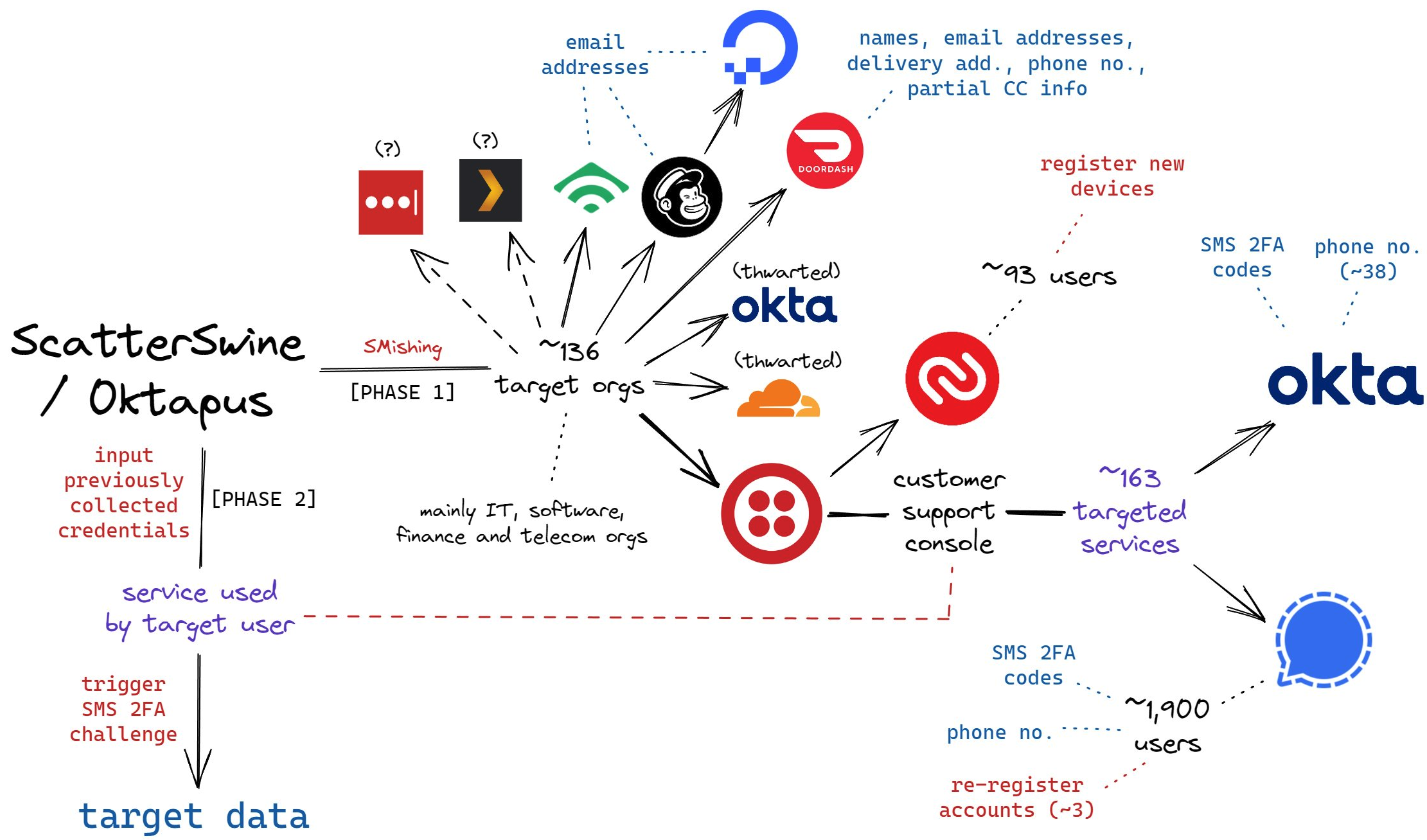
A flow chart of the attacks by the SMS phishing group known as 0ktapus and ScatterSwine. Image: Amitai Cohen for Wiz.io. twitter.com/amitaico.
The ubiquity of mobile phones became a lifeline for many companies trying to manage their remote employees throughout the Coronavirus pandemic. But these same mobile devices are fast becoming a liability for organizations that use them for phishable forms of multi-factor authentication, such as one-time codes generated by a mobile app or delivered via SMS.
Because as we can see from the success of this phishing group, this type of data extraction is now being massively automated, and employee authentication compromises can quickly lead to security and privacy risks for the employer’s partners or for anyone in their supply chain.
Unfortunately, a great many companies still rely on SMS for employee multi-factor authentication. According to a report this year from Okta, 47 percent of workforce customers deploy SMS and voice factors for multi-factor authentication. That’s down from 53 percent that did so in 2018, Okta found.
Some companies (like Knauer’s Sitel) have taken to requiring that all remote access to internal networks be managed through work-issued laptops and/or mobile devices, which are loaded with custom profiles that can’t be accessed through other devices.
Others are moving away from SMS and one-time code apps and toward requiring employees to use physical FIDO multi-factor authentication devices such as security keys, which can neutralize phishing attacks because any stolen credentials can’t be used unless the phishers also have physical access to the user’s security key or mobile device.
This came in handy for Twitter, which announced last year that it was moving all of its employees to using security keys, and/or biometric authentication via their mobile device. The phishers’ Telegram bot reported that on June 16, 2022, five employees at Twitter gave away their work credentials. In response to questions from KrebsOnSecurity, Twitter confirmed several employees were relieved of their employee usernames and passwords, but that its security key requirement prevented the phishers from abusing that information.
Twitter accelerated its plans to improve employee authentication following the July 2020 security incident, wherein several employees were phished and relieved of credentials for Twitter’s internal tools. In that intrusion, the attackers used Twitter’s tools to hijack accounts for some of the world’s most recognizable public figures, executives and celebrities — forcing those accounts to tweet out links to bitcoin scams.
“Security keys can differentiate legitimate sites from malicious ones and block phishing attempts that SMS 2FA or one-time password (OTP) verification codes would not,” Twitter said in an Oct. 2021 post about the change. “To deploy security keys internally at Twitter, we migrated from a variety of phishable 2FA methods to using security keys as our only supported 2FA method on internal systems.”
Update, 6:02 p.m. ET: Clarified that Cloudflare does not rely on TOTP (one-time multi-factor authentication codes) as a second factor for employee authentication.



Scammers are using invoices sent through PayPal.com to trick recipients into calling a number to dispute a pending charge. The missives — which come from Paypal.com and include a link at Paypal.com that displays an invoice for the supposed transaction — state that the user’s account is about to be charged hundreds of dollars. Recipients who call the supplied toll-free number to contest the transaction are soon asked to download software that lets the scammers assume remote control over their computer.
KrebsOnSecurity recently heard from a reader who received an email from paypal.com that he immediately suspected was phony. The message’s subject read, “Billing Department of PayPal updated your invoice.”
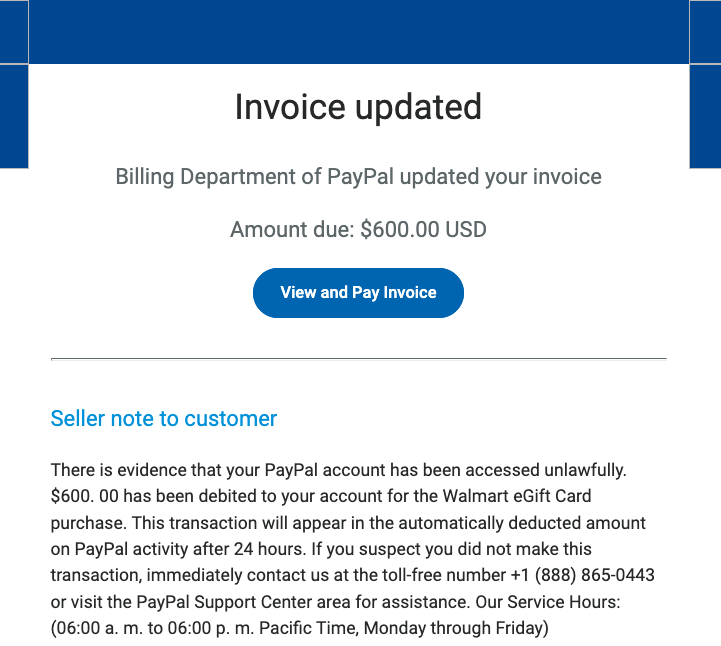
A copy of the phishing message included in the PayPal.com invoice.
While the phishing message attached to the invoice is somewhat awkwardly worded, there are many convincing aspects of this hybrid scam. For starters, all of the links in the email lead to paypal.com. Hovering over the “View and Pay Invoice” button shows the button indeed wants to load a link at paypal.com, and clicking that link indeed brings up an active invoice at paypal.com.
Also, the email headers in the phishing message (PDF) show that it passed all email validation checks as being sent by PayPal, and that it was sent through an Internet address assigned to PayPal.
Both the email and the invoice state that “there is evidence that your PayPal account has been accessed unlawfully.” The message continues:
“$600.00 has been debited to your account for the Walmart Gift Card purchase. This transaction will appear in the automatically deducted amount on PayPal activity after 24 hours. If you suspect you did not make this transaction, immediately contact us at the toll-free number….”
Here’s the invoice that popped up when the “View and Pay Invoice” button was clicked:
The reader who shared this phishing email said he logged into his PayPal account and could find no signs of the invoice in question. A call to the toll-free number listed in the invoice was received by a man who answered the phone as generic “customer service,” instead of trying to spoof PayPal or Walmart. Very quickly into the conversation he suggested visiting a site called globalquicksupport[.]com to download a remote administration tool. It was clear then where the rest of this call was going.
I can see this scam tricking a great many people, especially since both the email and invoice are sent through PayPal’s systems — which practically guarantees that the message will be successfully delivered. The invoices appear to have been sent from a compromised or fraudulent PayPal Business account, which allows users to send invoices like the one shown above. Details of this scam were shared Wednesday with PayPal’s anti-abuse (phishing@paypal.com) and media relations teams.
PayPal said in a written statement that phishing attempts are common and can take many forms.
“We have a zero-tolerance policy on our platform for attempted fraudulent activity, and our teams work tirelessly to protect our customers,” PayPal said. “We are aware of this well-known phishing scam and have put additional controls in place to mitigate this specific incident. Nonetheless, we encourage customers to always be vigilant online and to contact Customer Service directly if they suspect they are a target of a scam.”
It’s remarkable how well today’s fraudsters have adapted to hijacking the very same tools that financial institutions have long used to make their customers feel safe transacting online. It’s no accident that one of the most prolific scams going right now — the Zelle Fraud Scam — starts with a text message about an unauthorized payment that appears to come from your bank. After all, financial institutions have spent years encouraging customers to sign up for mobile alerts via SMS about suspicious transactions, and to expect the occasional inbound call about possibly fraudulent transactions.
Also, today’s scammers are less interested in stealing your PayPal login than they are in phishing your entire computer and online life with remote administration software, which seems to be the whole point of so many scams these days. Because why rob just one online account when you can plunder them all?
The best advice to sidestep phishing scams is to avoid clicking on links that arrive unbidden in emails, text messages and other mediums. Most phishing scams invoke a temporal element that warns of dire consequences should you fail to respond or act quickly. If you’re unsure whether the message is legitimate, take a deep breath and visit the site or service in question manually — ideally, using a browser bookmark to avoid potential typosquatting sites.



Earlier this month, the administrator of the cybercrime forum Breached received a cease-and-desist letter from a cybersecurity firm. The missive alleged that an auction on the site for data stolen from 10 million customers of Mexico’s second-largest bank was fake news and harming the bank’s reputation. The administrator responded to this empty threat by purchasing the stolen banking data and leaking it on the forum for everyone to download.
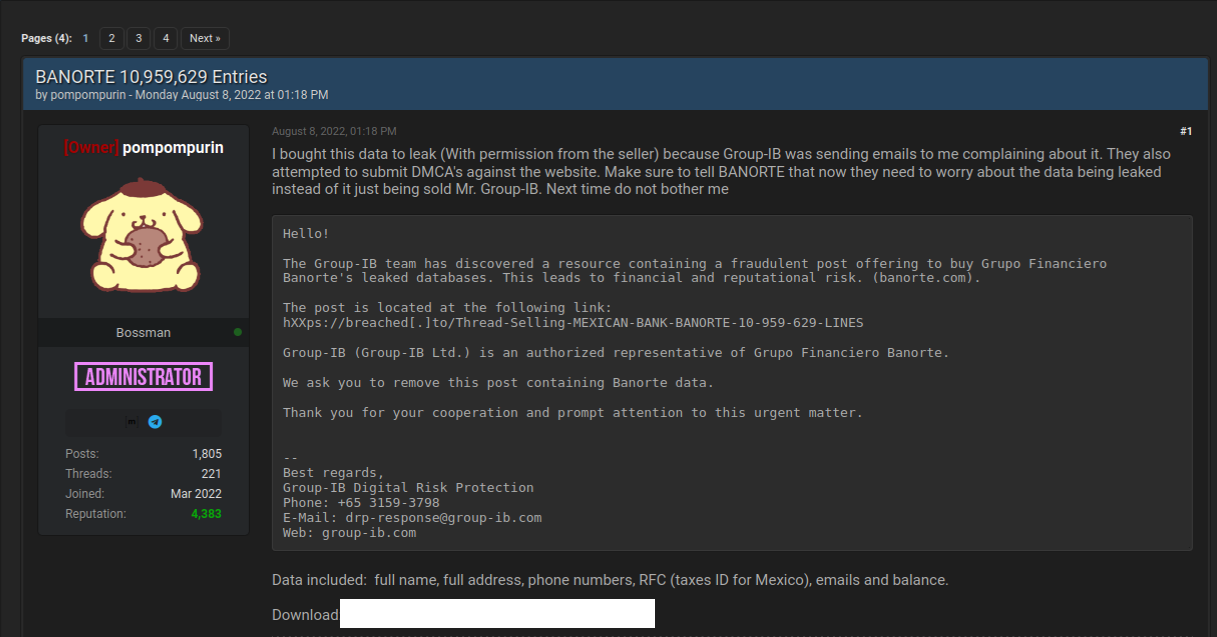
On August 3, 2022, someone using the alias “Holistic-K1ller” posted on Breached a thread selling data allegedly stolen from Grupo Financiero Banorte, Mexico’s second-biggest financial institution by total loans. Holistic-K1ller said the database included the full names, addresses, phone numbers, Mexican tax IDs (RFC), email addresses and balances on more than 10 million citizens.
There was no reason to believe Holistic-K1ller had fabricated their breach claim. This identity has been highly active on Breached and its predecessor RaidForums for more than two years, mostly selling databases from hacked Mexican entities. Last month, they sold customer information on 36 million customers of the Mexican phone company Telcel; in March, they sold 33,000 images of Mexican IDs — with the front picture and a selfie of each citizen. That same month, they also sold data on 1.4 million customers of Mexican lending platform Yotepresto.
But this history was either overlooked or ignored by Group-IB, the Singapore-based cybersecurity firm apparently hired by Banorte to help respond to the data breach.
“The Group-IB team has discovered a resource containing a fraudulent post offering to buy Grupo Financiero Banorte’s leaked databases,” reads a letter the Breach administrator said they received from Group-IB. “We ask you to remove this post containing Banorte data. Thank you for your cooperation and prompt attention to this urgent matter.”
The administrator of Breached is “Pompompurin,” the same individual who alerted this author in November 2021 to a glaring security hole in a U.S. Justice Department website that was used to spoof security alerts from the FBI. In a post to Breached on Aug. 8, Pompompurin said they bought the Banorte database from Holistic-K1ller’s sales thread because Group-IB was sending emails complaining about it.
“They also attempted to submit DMCA’s against the website,” Pompompurin wrote, referring to legal takedown requests under the Digital Millennium Copyright Act. “Make sure to tell Banorte that now they need to worry about the data being leaked instead of just being sold.”
Group-IB CEO Dmitriy Volkov said the company has seen some success in the past asking hackers to remove or take down certain information, but that making such requests is not a typical response for the security firm.
“It is not a common practice to send takedown notifications to such forums demanding that such content be removed,” Volkov said. “But these abuse letters are legally binding, which helps build a foundation for further steps taken by law enforcement agencies. Actions contrary to international rules in the regulated space of the Internet only lead to more severe crimes, which — as we know from the case of Raidforums — are successfully investigated and stopped by law enforcement.”
Banorte did not respond to requests for comment. But in a brief written statement picked up on Twitter, Banorte said there was no breach involving their infrastructure, and the data being sold is old.
“There has been no violation of our platforms and technological infrastructure,” Banorte said. “The set of information referred to is inaccurate and outdated, and does not put our users and customers at risk.”
That statement may be 100 percent true. Still, it is difficult to think of a better example of how not to do breach response. Banorte shrugging off this incident as a nothingburger is baffling: While it is almost certainly true that the bank balance information in the Banorte leak is now out of date, the rest of the information (tax IDs, phone numbers, email addresses) is harder to change.
“Is there one person from our community that think sending cease and desist letter to a hackers forum operator is a good idea?,” asked Ohad Zaidenberg, founder of CTI League, a volunteer emergency response community that emerged in 2020 to help fight COVID-19 related scams. “Who does it? Instead of helping, they pushed the organization from the hill.”
Kurt Seifried, director of IT for the CloudSecurityAlliance, was similarly perplexed by the response to the Banorte breach.
“If the data wasn’t real….did the bank think a cease and desist would result in the listing being removed?” Seifried wondered on Twitter. “I mean, isn’t selling breach data a worse crime usually than slander or libel? What was their thought process?”
A more typical response when a large bank suspects a breach is to approach the seller privately through an intermediary to ascertain if the information is valid and what it might cost to take it off the market. While it may seem odd to expect cybercriminals to make good on their claims to sell stolen data to only one party, removing sold stolen items from inventory is a fairly basic function of virtually all cybercriminal markets today (apart from perhaps sites that traffic in stolen identity data).
At a minimum, negotiating or simply engaging with a data seller can buy the victim organization additional time and clues with which to investigate the claim and ideally notify affected parties of a breach before the stolen data winds up online.
It is true that a large number of hacked databases put up for sale on the cybercrime underground are sold only after a small subset of in-the-know thieves have harvested all of the low-hanging fruit in the data — e.g., access to cryptocurrency accounts or user credentials that are recycled across multiple websites. And it’s certainly not unheard of for cybercriminals to go back on their word and re-sell or leak information that they have sold previously.
But companies in the throes of responding to a data security incident do themselves and customers no favors when they underestimate their adversaries, or try to intimidate cybercrooks with legal threats. Such responses generally accomplish nothing, except unnecessarily upping the stakes for everyone involved while displaying a dangerous naiveté about how the cybercrime underground works.
Update, Aug. 17, 10:32 a.m.: Thanks to a typo by this author, a request for comment sent to Group-IB was not delivered in advance of this story. The copy above has been updated to include a comment from Group-IB’s CEO.









Earlier this year, our global Connected Family Study revealed the online habits of parents and their children. What we found called for a closer look.
One finding that leaped out, in particular, is—cyberbullying occurs far more often than parents think. And in many cases, children are keeping it from their parents.
Now with our follow-on research, we set out to answer many of the questions families have about cyberbullying. Where it happens most, who’s most affected, and are children cyberbullying others without even knowing it?
Our report, “Hidden in Plain Sight: More Dangers of Cyberbullying Emerge,” provides insights into these questions and several more. We’ll cover the top findings here in this blog, while you can get the full story by downloading the report here.
Even as stay-at-home mandates in 2020 and 2021 saw children exposed to more cyberbullying while they spent more time online, our ten-country survey found that concerns about cyberbullying in 2022 are even higher today:
And just as the level of concern is high, the findings show us why. Families reported alarming rates of racially motivated cyberbullying, along with high rates of attacks on the major social media and messaging platforms.
Additionally, children shared insights into who’s doing the bullying (it’s largely people who know them) and more than half are the ones doing the bullying—and they don’t even realize it.
Further findings include:
Our research further revealed how the face of cyberbullying takes on different form around the globe. From nation to nation, the influences of polarized politics, racial relations, and different traditions in parent-child relationships shape and re-shape the forms of cyberbullying that children see.
Each of our ten nations surveyed set themselves apart with trends of their own, some of them including:

These new findings reflect the concerns of parents and children alike—cyberbullying remains a pervasive and potentially harmful fact of life online, particularly as racism and other severe forms of cyberbullying take rise.
Without question, cyberbullying endures as a persistent growing pain that the still relatively young internet has yet to shake.
The solution is arguably just as complex as the factors that give cyberbullying its shape—cultural, regional, technological, societal, even governmental. Addressing one factor alone won’t curb it. Significantly curtailing cyberbullying for an internet that’s far safer than it is today requires addressing those factors in concert.
While we recognize that tall order for what it is, and as a leader in online protection, we remain committed to it.
With these findings, and continued research to come, our aim is to further an understanding of cyberbullying for all—whether that’s educators, technology innovators, policymakers, and of course parents. With this understanding, programs, platforms, and legislation can put protections in place that still allow for companies to innovate and create platforms that people love to use. Safely and securely.
The post More Dangers of Cyberbullying Emerge—Our Latest Connected Family Report appeared first on McAfee Blog.
Microsoft today released updates to fix a record 141 security vulnerabilities in its Windows operating systems and related software. Once again, Microsoft is patching a zero-day vulnerability in the Microsoft Support Diagnostics Tool (MSDT), a service built into Windows. Redmond also addressed multiple flaws in Exchange Server — including one that was disclosed publicly prior to today — and it is urging organizations that use Exchange for email to update as soon as possible and to enable additional protections.

In June, Microsoft patched a vulnerability in MSDT dubbed “Follina” that had been used in active attacks for at least three months prior. This latest MSDT bug — CVE-2022-34713 — is a remote code execution flaw that requires convincing a target to open a booby-trapped file, such as an Office document. Microsoft this month also issued a different patch for another MSDT flaw, tagged as CVE-2022-35743.
The publicly disclosed Exchange flaw is CVE-2022-30134, which is an information disclosure weakness. Microsoft also released fixes for three other Exchange flaws that rated a “critical” label, meaning they could be exploited remotely to compromise the system and with no help from users. Microsoft says addressing some of the Exchange vulnerabilities fixed this month requires administrators to enable Windows Extended protection on Exchange Servers. See Microsoft’s blog post on the Exchange Server updates for more details.
“If your organization runs local exchange servers, this trio of CVEs warrant an urgent patch,” said Kevin Breen, director of cyber threat research for Immerse Labs. “Exchanges can be treasure troves of information, making them valuable targets for attackers. With CVE-2022-24477, for example, an attacker can gain initial access to a user’s host and could take over the mailboxes for all exchange users, sending and reading emails and documents. For attackers focused on Business Email Compromise this kind of vulnerability can be extremely damaging.”
The other two critical Exchange bugs are tracked as CVE-2022-24516 and CVE-2022-21980. It’s difficult to believe it’s only been a little more than a year since malicious hackers worldwide pounced in a bevy of zero-day Exchange vulnerabilities to remotely compromise the email systems for hundreds of thousands of organizations running Exchange Server locally for email. That lingering catastrophe is reminder enough that critical Exchange bugs deserve immediate attention.
The SANS Internet Storm Center‘s rundown on Patch Tuesday warns that a critical remote code execution bug in the Windows Point-to-Point Protocol (CVE-2022-30133) could become “wormable” — a threat capable of spreading across a network without any user interaction.
“Another critical vulnerability worth mentioning is an elevation of privilege affecting Active Directory Domain Services (CVE-2022-34691),” SANS wrote. “According to the advisory, ‘An authenticated user could manipulate attributes on computer accounts they own or manage, and acquire a certificate from Active Directory Certificate Services that would allow elevation of privilege to System.’ A system is vulnerable only if Active Directory Certificate Services is running on the domain. The CVSS for this vulnerability is 8.8.”
Breen highlighted a set of four vulnerabilities in Visual Studio that earned Microsoft’s less-dire “important” rating but that nevertheless could be vitally important for the security of developer systems.
“Developers are empowered with access to API keys and deployment pipelines that, if compromised, could be significantly damaging to organizations,” he said. “So it’s no surprise they are often targeted by more advanced attackers. Patches for their tools should not be overlooked. We’re seeing a continued trend of supply-chain compromise too, making it vital that we ensure developers, and their tools, are kept up-to-date with the same rigor we apply to standard updates.”
Greg Wiseman, product manager at Rapid7, pointed to an interesting bug Microsoft patched in Windows Hello, the biometric authentication mechanism for Windows 10. Microsoft notes that the successful exploitation of the weakness requires physical access to the target device, but would allow an attacker to bypass a facial recognition check.
Wiseman said despite the record number of vulnerability fixes from Redmond this month, the numbers are slightly less dire.
“20 CVEs affect their Chromium-based Edge browser and 34 affect Azure Site Recovery (up from 32 CVEs affecting that product last month),” Wiseman wrote. “As usual, OS-level updates will address a lot of these, but note that some extra configuration is required to fully protect Exchange Server this month.”
As it often does on Patch Tuesday, Adobe has also released security updates for many of its products, including Acrobat and Reader, Adobe Commerce and Magento Open Source. More details here.
Please consider backing up your system or at least your important documents and data before applying system updates. And if you run into any problems with these updates, please drop a note about it here in the comments.

Email scammers sent an Uber to the home of an 80-year-old woman who responded to a well-timed email scam, in a bid to make sure she went to the bank and wired money to the fraudsters. In this case, the woman figured out she was being scammed before embarking for the bank, but her story is a chilling reminder of how far crooks will go these days to rip people off.
Travis Hardaway is a former music teacher turned app developer from Towson, Md. Hardaway said his mother last month replied to an email she received regarding an appliance installation from BestBuy/GeekSquad. Hardaway said the timing of the scam email couldn’t have been worse: His mom’s dishwasher had just died, and she’d paid to have a new one delivered and installed.
“I think that’s where she got confused, because she thought the email was about her dishwasher installation,” Hardaway told KrebsOnSecurity.
Hardaway said his mom initiated a call to the phone number listed in the phony BestBuy email, and that the scammers told her she owed $160 for the installation, which seemed right at the time. Then the scammers asked her to install remote administration software on her computer so that they could control the machine from afar and assist her in making the payment.
After she logged into her bank and savings accounts with scammers watching her screen, the fraudster on the phone claimed that instead of pulling $160 out of her account, they accidentally transferred $160,000 to her account. They said they they needed her help to make sure the money was “returned.”
“They took control of her screen and said they had accidentally transferred $160,000 into her account,” Hardaway said. “The person on the phone told her he was going to lose his job over this transfer error, that he didn’t know what to do. So they sent her some information about where to wire the money, and asked her to go to the bank. But she told them, ‘I don’t drive,’ and they told her, “No problem, we’re sending an Uber to come help you to the bank.'”
Hardaway said he was out of town when all this happened, and that thankfully his mom eventually grew exasperated and gave up trying to help the scammers.
“They told her they were sending an Uber to pick her up and that it was on its way,” Hardaway said. “I don’t know if the Uber ever got there. But my mom went over to the neighbor’s house and they saw it for what it was — a scam.”
Hardaway said he has since wiped her computer, reinstalled the operating system and changed her passwords. But he says the incident has left his mom rattled.
“She’s really second-guessing herself now,” Hardaway said. “She’s not computer-savvy, and just moved down here from Boston during COVID to be near us, but she’s living by herself and feeling isolated and vulnerable, and stuff like this doesn’t help.”
According to the Federal Bureau of Investigation (FBI), seniors are often targeted because they tend to be trusting and polite. More importantly, they also usually have financial savings, own a home, and have good credit—all of which make them attractive to scammers.
“Additionally, seniors may be less inclined to report fraud because they don’t know how, or they may be too ashamed of having been scammed,” the FBI warned in May. “They might also be concerned that their relatives will lose confidence in their abilities to manage their own financial affairs. And when an elderly victim does report a crime, they may be unable to supply detailed information to investigators.”
In 2021, more than 92,000 victims over the age of 60 reported losses of $1.7 billion to the FBI’s Internet Crime Complaint Center (IC3). The FBI says that represents a 74 percent increase in losses over losses reported in 2020.
The abuse of ride-sharing services to scam the elderly is not exactly new. Authorities in Tampa, Fla. say they’re investigating an incident from December 2021 where fraudsters who’d stolen $700,000 from elderly grandparents used Uber rides to pick up bundles of cash from their victims.
With the recent demise of several popular “proxy” services that let cybercriminals route their malicious traffic through hacked PCs, there is now something of a supply chain crisis gripping the underbelly of the Internet. Compounding the problem, several remaining malware-based proxy services have chosen to block new registrations to avoid swamping their networks with a sudden influx of customers.

Last week, a seven-year-old proxy service called 911[.]re abruptly announced it was permanently closing after a cybersecurity breach allowed unknown intruders to trash its servers and delete customer data and backups. 911 was already akin to critical infrastructure for many in the cybercriminal community after its top two competitors — VIP72 and LuxSocks — closed or were shut down by authorities over the past 10 months.
The underground cybercrime forums are now awash in pleas from people who are desperately seeking a new supplier of abundant, cheap, and reliably clean proxies to restart their businesses. The consensus seems to be that those days are now over, and while there are many smaller proxy services remaining, few of them on their own are capable of absorbing anywhere near the current demand.
“Everybody is looking for an alternative, bro,” wrote a BlackHatForums user on Aug. 1 in response to one of many “911 alternative” discussion threads. “No one knows an equivalent alternative to 911[.]re. Their service in terms of value and accessibility compared to other proxy providers was unmatched. Hopefully someone comes with a great alternative to 911[.]re.”
Among the more frequently recommended alternatives to 911 is SocksEscort[.]com, a malware-based proxy network that has been in existence since at least 2010. Here’s what part of their current homepage looks like:
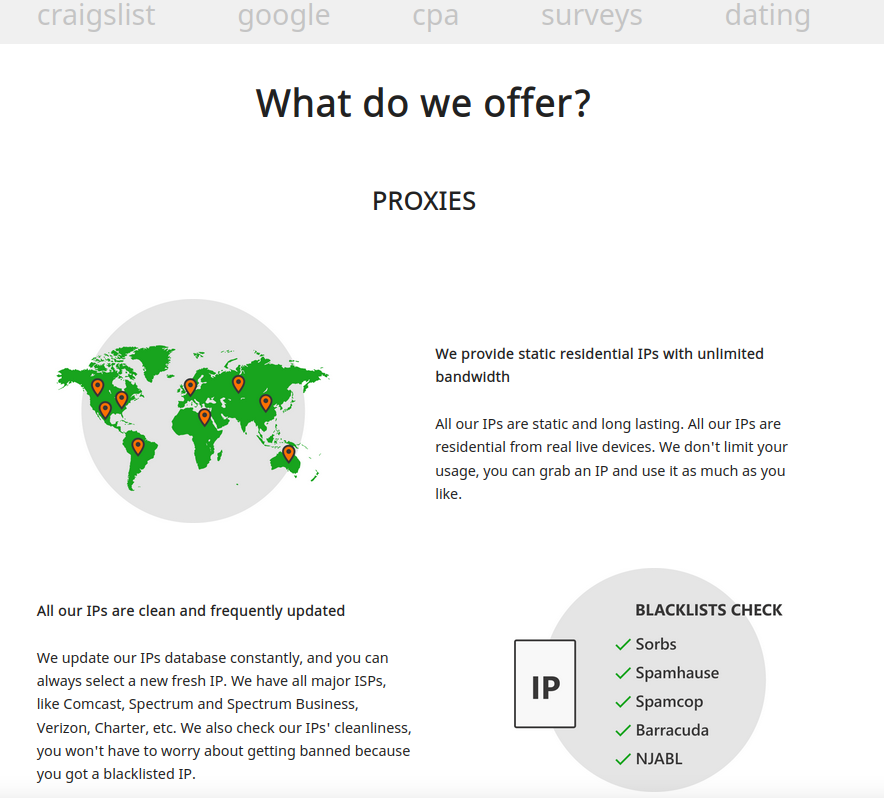
The SocksEscort home page says its services are perfect for people involved in automated online activity that often results in IP addresses getting blocked or banned, such as Craigslist and dating scams, search engine results manipulation, and online surveys.
But faced with a deluge of new signups in the wake of 911’s implosion, SocksEscort was among the remaining veteran proxy services that opted to close its doors to new registrants, replacing its registration page with the message:
“Due to unusual high demand, and heavy load on our servers, we had to block all new registrations. We won’t be able to support our proxies otherwise, and close SocksEscort as a result. We will resume registrations right after demand drops. Thank you for understanding, and sorry for the inconvenience.”
According to Spur.us, a startup that tracks proxy services, SocksEscort is a malware-based proxy offering, which means the machines doing the proxying of traffic for SocksEscort customers have been infected with malicious software that turns them into a traffic relay.
Spur says SocksEscort’s proxy service relies on software designed to run on Windows computers, and is currently leasing access to more than 14,000 hacked computers worldwide. That is a far cry from the proxy inventory advertised by 911, which stood at more than 200,000 IP addresses for rent just a few days ago.
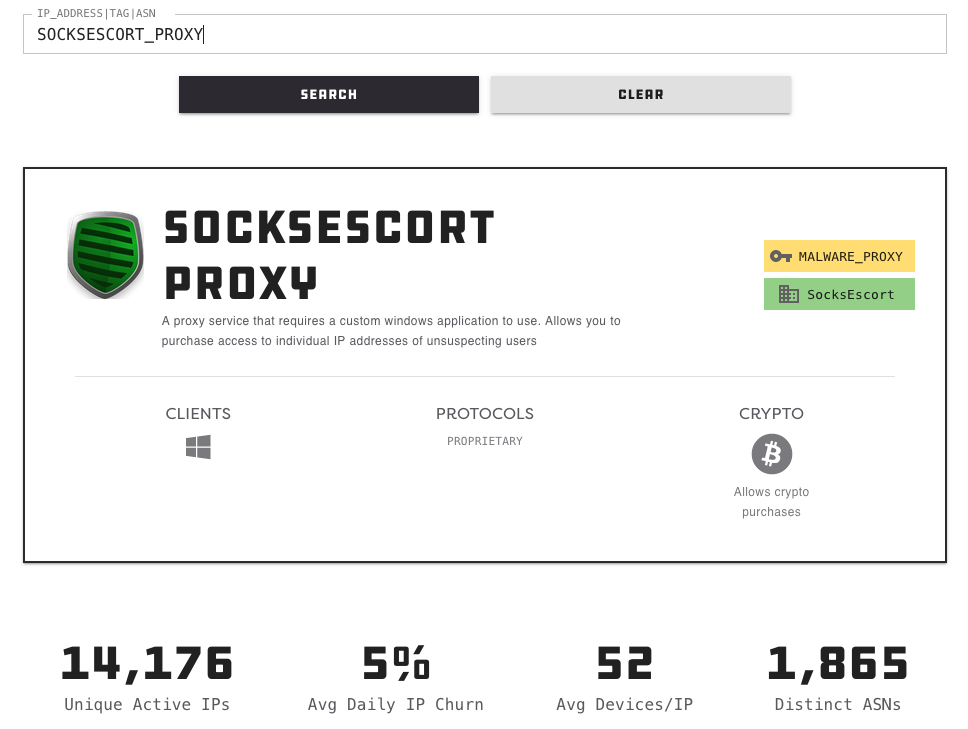
Image: Spur.us
SocksEscort is what’s known as a “SOCKS Proxy” service. The SOCKS (or SOCKS5) protocol allows Internet users to channel their Web traffic through a proxy server, which then passes the information on to the intended destination. From a website’s perspective, the traffic of the proxy network customer appears to originate from a rented/malware-infected PC tied to a residential ISP customer, not from the proxy service customer.
These services can be used in a legitimate manner for several business purposes — such as price comparisons or sales intelligence — but they are massively abused for hiding cybercrime activity because they make it difficult to trace malicious traffic to its original source.
The disruption at 911[.]re came days after KrebsOnSecurity published an in-depth look at the long-running proxy service, which showed that 911 had a history of incentivizing the installation of its proxy software without user notice or consent, and that it actually ran some of these “pay-per-install” schemes on its own to guarantee a steady supply of freshly-hacked PCs.
More on SocksEscort in an upcoming story.
Further reading:
July 29, 2022: 911 Proxy Service Implodes After Disclosing Breach
July 28, 2022: Breach Exposes Users of Microleaves Proxy Service
July 18, 2022: A Deep Dive Into the Residential Proxy Service ‘911’
June 28, 2022: The Link Between AWM Proxy & the Glupteba Botnet
June 22, 2022: Meet the Administrators of the RSOCKS Proxy Botnet
Sept. 1, 2021: 15-Year-Old Malware Proxy Network VIP72 Goes Dark




The 911 service as it existed until July 28, 2022.
911[.]re, a proxy service that since 2015 has sold access to hundreds of thousands of Microsoft Windows computers daily, announced this week that it is shutting down in the wake of a data breach that destroyed key components of its business operations. The abrupt closure comes ten days after KrebsOnSecurity published an in-depth look at 911 and its connections to shady pay-per-install affiliate programs that secretly bundled 911’s proxy software with other titles, including “free” utilities and pirated software.
911[.]re is was one of the original “residential proxy” networks, which allow someone to rent a residential IP address to use as a relay for his/her Internet communications, providing anonymity and the advantage of being perceived as a residential user surfing the web.
Residential proxy services are often marketed to people seeking the ability to evade country-specific blocking by the major movie and media streaming providers. But some of them — like 911 — build their networks in part by offering “free VPN” or “free proxy” services that are powered by software which turns the user’s PC into a traffic relay for other users. In this scenario, users indeed get to use a free VPN service, but they are often unaware that doing so will turn their computer into a proxy that lets others use their Internet address to transact online.
From a website’s perspective, the IP traffic of a residential proxy network user appears to originate from the rented residential IP address, not from the proxy service customer. These services can be used in a legitimate manner for several business purposes — such as price comparisons or sales intelligence — but they are massively abused for hiding cybercrime activity because they can make it difficult to trace malicious traffic to its original source.
As noted in KrebsOnSecurity’s July 19 story on 911, the proxy service operated multiple pay-per-install schemes that paid affiliates to surreptitiously bundle the proxy software with other software, continuously generating a steady stream of new proxies for the service.

A cached copy of flashupdate[.]net circa 2016, which shows it was the homepage of a pay-per-install affiliate program that incentivized the silent installation of 911’s proxy software.
Within hours of that story, 911 posted a notice at the top of its site, saying, “We are reviewing our network and adding a series of security measures to prevent misuse of our services. Proxy balance top-up and new user registration are closed. We are reviewing every existing user, to ensure their usage is legit and [in] compliance with our Terms of Service.”
At this announcement, all hell broke loose on various cybercrime forums, where many longtime 911 customers reported they were unable to use the service. Others affected by the outage said it seemed 911 was trying to implement some sort of “know your customer” rules — that maybe 911 was just trying to weed out those customers using the service for high volumes of cybercriminal activity.
Then on July 28, the 911 website began redirecting to a notice saying, “We regret to inform you that we permanently shut down 911 and all its services on July 28th.”
According to 911, the service was hacked in early July, and it was discovered that someone manipulated the balances of a large number of user accounts. 911 said the intruders abused an application programming interface (API) that handles the topping up of accounts when users make financial deposits with the service.
“Not sure how did the hacker get in,” the 911 message reads. “Therefore, we urgently shut down the recharge system, new user registration, and an investigation started.”
However the intruders got in, 911 said, they managed to also overwrite critical 911[.]re servers, data and backups of that data.
“On July 28th, a large number of users reported that they could not log in the system,” the statement continues. “We found that the data on the server was maliciously damaged by the hacker, resulting in the loss of data and backups. Its [sic] confirmed that the recharge system was also hacked the same way. We were forced to make this difficult decision due to the loss of important data that made the service unrecoverable.”
Operated largely out of China, 911 was an enormously popular service across many cybercrime forums, and it became something akin to critical infrastructure for this community after two of 911’s longtime competitors — malware-based proxy services VIP72 and LuxSocks — closed their doors in the past year.
Now, many on the crime forums who relied on 911 for their operations are wondering aloud whether there are any alternatives that match the scale and utility that 911 offered. The consensus seems to be a resounding “no.”
I’m guessing we may soon learn more about the security incidents that caused 911 to implode. And perhaps other proxy services will spring up to meet what appears to be a burgeoning demand for such services at the moment, with comparatively little supply.
In the meantime, 911’s absence may coincide with a measurable (if only short-lived) reprieve in unwanted traffic to top Internet destinations, including banks, retailers and cryptocurrency platforms, as many former customers of the proxy service scramble to make alternative arrangements.
Riley Kilmer, co-founder of the proxy-tracking service Spur.us, said 911’s network will be difficult to replicate in the short run.
“My speculation is [911’s remaining competitors] are going to get a major boost in the short term, but a new player will eventually come along,” Kilmer said. “None of those are good replacements for LuxSocks or 911. However, they will all allow anyone to use them. For fraud rates, the attempts will continue but through these replacement services which should be easier to monitor and stop. 911 had some very clean IP addresses.”
911 wasn’t the only major proxy provider disclosing a breach this week tied to unauthenticated APIs: On July 28, KrebsOnSecurity reported that internal APIs exposed to the web had leaked the customer database for Microleaves, a proxy service that rotates its customers’ IP addresses every five to ten minutes. That investigation showed Microleaves — like 911 — had a long history of using pay-per-install schemes to spread its proxy software.



U.S. state and federal investigators are being inundated with reports from people who’ve lost hundreds of thousands or millions of dollars in connection with a complex investment scam known as “pig butchering,” wherein people are lured by flirtatious strangers online into investing in cryptocurrency trading platforms that eventually seize any funds when victims try to cash out.

The term “pig butchering” refers to a time-tested, heavily scripted, and human-intensive process of using fake profiles on dating apps and social media to lure people into investing in elaborate scams. In a more visceral sense, pig butchering means fattening up a prey before the slaughter.
“The fraud is named for the way scammers feed their victims with promises of romance and riches before cutting them off and taking all their money,” the Federal Bureau of Investigation (FBI) warned in April 2022. “It’s run by a fraud ring of cryptocurrency scammers who mine dating apps and other social media for victims and the scam is becoming alarmingly popular.”
As documented in a series of investigative reports published over the past year across Asia, the people creating these phony profiles are largely men and women from China and neighboring countries who have been kidnapped and trafficked to places like Cambodia, where they are forced to scam complete strangers over the Internet — day after day.
The most prevalent pig butchering scam today involves sophisticated cryptocurrency investment platforms, where investors invariably see fantastic returns on their deposits — until they try to withdraw the funds. At that point, investors are told they owe huge tax bills. But even those who pay the phony levies never see their money again.
The come-ons for these scams are prevalent on dating sites and apps, but they also frequently start with what appears to be a wayward SMS — such as an instant message about an Uber ride that never showed. Or a reminder from a complete stranger about a planned meetup for coffee. In many ways, the content of the message is irrelevant; the initial goal to simply to get the recipient curious enough to respond in some way.
Those who respond are asked to continue the conversation via WhatsApp, where an attractive, friendly profile of the opposite gender will work through a pre-set script that is tailored to their prey’s apparent socioeconomic situation. For example, a divorced, professional female who responds to these scams will be handled with one profile type and script, while other scripts are available to groom a widower, a young professional, or a single mom.
That’s according to Erin West, deputy district attorney for Santa Clara County in Northern California. West said her office has been fielding a large number of pig butchering inquiries from her state, but also from law enforcement entities around the country that are ill-equipped to investigate such fraud.
“The people forced to perpetrate these scams have a guide and a script, where if your victim is divorced say this, or a single mom say this,” West said. “The scale of this is so massive. It’s a major problem with no easy answers, but also with victim volumes I’ve never seen before. With victims who are really losing their minds and in some cases are suicidal.”
West is a key member of REACT, a task force set up to tackle especially complex forms of cyber theft involving virtual currencies. West said the initial complaints from pig butchering victims came early this year.
“I first thought they were one-off cases, and then I realized we were getting these daily,” West said. “A lot of them are being reported to local agencies that don’t know what to do with them, so the cases languish.”
West said pig butchering victims are often quite sophisticated and educated people.
“One woman was a university professor who lost her husband to COVID, got lonely and was chatting online, and eventually ended up giving away her retirement,” West recalled of a recent case. “There are just horrifying stories that run the gamut in terms of victims, from young women early in their careers, to senior citizens and even to people working in the financial services industry.”
In some cases reported to REACT, the victims said they spent days or weeks corresponding with the phony WhatsApp persona before the conversation shifted to investing.
“They’ll say ‘Hey, this is the food I’m eating tonight’ and the picture they share will show a pretty setting with a glass of wine, where they’re showcasing an enviable lifestyle but not really mentioning anything about how they achieved that,” West said. “And then later, maybe a few hours or days into the conversation, they’ll say, ‘You know I made some money recently investing in crypto,’ kind of sliding into the topic as if this wasn’t what they were doing the whole time.”
Curious investors are directed toward elaborate and official-looking online crypto platforms that appear to have thousands of active investors. Many of these platforms include extensive study materials and tutorials on cryptocurrency investing. New users are strongly encouraged to team up with more seasoned investors on the platform, and to make only small investments that they can afford to lose.
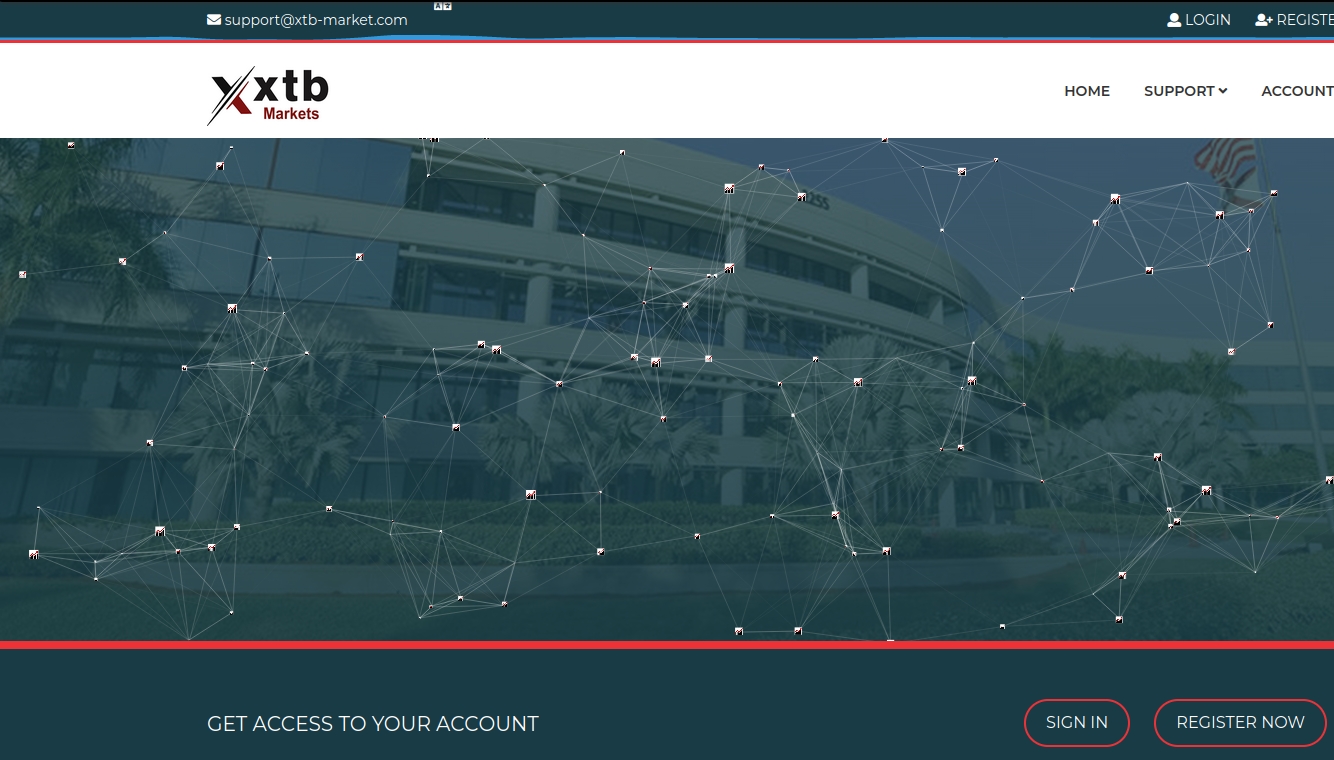
The now-defunct homepage of xtb-market[.]com, a scam cryptocurrency platform tied to a pig butchering scheme.
“They’re able to see some value increase, and maybe even be allowed to take out that value increase so that they feel comfortable about the situation,” West said. Some investors then need little encouragement to deposit additional funds, which usually generate increasingly higher “returns.”
West said many crypto trading platforms associated with pig butchering scams appear to have been designed much like a video game, where investor hype is built around upcoming “trading opportunities” that hint at even more fantastic earnings.
“There are bonus levels and VIP levels, and they’ll build hype and a sense of frenzy into the trading,” West said. “There are definitely some psychological mechanisms at work to encourage people to invest more.”
“What’s so devastating about many of the victims is they lose that sense of who they are,” she continued. “They thought they were a savvy, sophisticated person, someone who’s sort of immune to scams. I think the large scale of the trickery and psychological manipulation being used here can’t be understated. It’s like nothing I’ve seen before.”
Courtney Nolan, a divorced mother of three daughters, says she lost more than $5 million to a pig butchering scam. Nolan lives in St. Louis and has a background in investment finance, but only started investing in cryptocurrencies in the past year.
Nolan’s case may be especially bad because she was already interested in crypto investing when the scammer reached out. At the time, Bitcoin was trading at or near all-time highs of nearly $68,000 per coin.
Nolan said her nightmare began in late 2021 with a Twitter direct message from someone who was following many of the same cryptocurrency influencers she followed. Her fellow crypto enthusiast then suggested they continue their discussion on WhatsApp. After much back and forth about his trading strategies, her new friend agreed to mentor her on how to make reliable profits using the crypto trading platform xtb.com.
“I had dabbled in leveraged trading before, but his mentor program gave me over 100 pages of study materials and agreed to walk me through their investment strategies over the course of a year,” Nolan told KrebsOnSecurity.
Nolan’s mentor had her create an account website xtb-market[.]com, which was made to be confusingly similar to XTB’s official platform. The site promoted several different investment packages, including a “starter plan” that involves a $5,250 up-front investment and promises more than 15 percent return across four separate trading bursts.
Platinum plans on xtb-market promised a whopping 45 percent ROI, with a minimum investment of $265,000. The site also offered a generous seven percent commission for referrals, which encouraged new investors to recruit others.

The now-defunct xtb-market[.]com.
While chatting via WhatsApp, Nolan and her mentor would trade side by side in xtb-market, initially with small investments ranging from $500 to $5,000. When those generated hefty returns, Nolan made bigger deposits. On several occasions she was able to withdraw amounts ranging from $10,000 to $30,000.
But after investing more than $4.5 million of her own money over nearly four months, Nolan found her account was suddenly frozen. She was then issued a tax statement saying she owed nearly $500,000 in taxes before she could reactivate her account or access her funds.
Nolan said it seems obvious in hindsight that she should never have paid the tax bill. Because xtb-market and her mentor cut all communications with her after that, and the entire website disappeared just a few weeks later.
Justin Maile, an investigation partner manager at Chainalysis, told Vice News that the tax portion of the pig butchering scam relies on the “sunk costs fallacy,” when people are reluctant to abandon a failing strategy or course of action because they have already invested heavily in it.
“Once the victim starts getting skeptical or tries to withdraw their funds, they are often told that they have to pay tax on the gains before funds can be unlocked,” Maile told Vice News. “The scammers will try to get any last payments out of the victims by exploiting the sunk cost fallacy and dangling huge profits in front of them.”
Vice recently published an in-depth report on pig butchering’s link to organized crime gangs in Asia that lure young job seekers with the promise of customer service jobs in call centers. Instead, those who show up at the appointed place and time are taken on long car rides and/or forced hikes across the borders into Cambodia, where they are pressed into indentured servitude.
Vice found many of the people forced to work in pig-butchering scams are being held in Chinese-owned casinos operating in Cambodia. Many of those casinos were newly built when the Covid pandemic hit. As the new casinos and hotels sat empty, organized crime groups saw an opportunity to use these facilities to generate huge income streams, and many foreign travelers stranded in neighboring countries were eventually trafficked to these scam centers.
Vice reports:
“While figures on the number of people in scam centers in Cambodia is unknown, best estimates pieced together from various sources point to the tens of thousands across scam centers in Sihanoukville, Phnom Penh, and sites in border regions Poipet and Bavet. In April, Thailand’s assistant national police commissioner said 800 Thai citizens had been rescued from scam centers in Cambodia in recent months, with a further 1,000 citizens still trapped across the country. One Vietnamese worker estimated 300 of his compatriots were held on just one floor in a tall office block hosting scam operations.”
“…within Victory Paradise Resort alone there were 7,000 people, the majority from mainland China, but also Indonesians, Singaporeans and Filipinos. According to the Khmer Times, one 10-building complex of high-rises in Sihanoukville, known as The China Project, holds between 8,000 to 10,000 people participating in various scams—a workforce that would generate profits around the $1 billion mark each year at $300 per worker per day.”
REACTs’ West said while there are a large number of pig butchering victims reporting their victimization to the FBI, very few are receiving anything more than instructions about filing a complaint with the FBI’s Internet Crime Complaint Center (IC3), which keeps track of cybercrime losses and victims.
“There’s a huge gap in victims that are seeing any kind of service at all, where they’re reporting to the FBI but not being able to talk to anyone,” she said. “They’re filling out the IC3 form and never hearing back. It sort of feels like the federal government is ignoring this, so people are going to local agencies, which are sending these victims our way.”
For many younger victims of pig butchering, even losses of a few thousand dollars can be financially devastating. KrebsOnSecurity recently heard from two different readers who said they were in their 20s and lost more than $40,000 each when the investment platforms they were trading on vanished with their money.
The FBI can often bundle numerous IC3 complaints involving the same assailants and victims into a single case for federal prosecutors to pursue the guilty, and/or try to recapture what was stolen. In general, however, victims of crypto crimes rarely see that money again, or if they do it can take many years.
“The next piece is what can we actually do with these cases,” West said. “We used to frame success as getting bad people behind bars, but these cases leave us as law enforcement with not a lot of opportunity there.”
West said the good news is U.S. authorities are seeing some success in freezing cryptocurrency wallets suspected of being tied to large-scale cybercriminal operations. Indeed, Nolan told KrebsOnSecurity that her losses were substantial enough to warrant an official investigation by the FBI, which she says has since taken steps to freeze at least some of the assets tied to xtb-market[.]com.
Likewise, West said she was recently able to freeze cryptocurrency funds stolen from some pig butchering victims, and now REACT is focusing on helping state and local authorities learn how to do the same.
“It’s important to be able to mobilize quickly and know how to freeze and seize crypto and get it back to its rightful owner,” West said. “We definitely have made seizures in cases involving pig butchering, but we haven’t gotten that back to the rightful owners yet.”
In April, the FBI warned Internet users to be on guard against pig butchering scams, which it said attracts victims with “promises of romance and riches” before duping them out of their money. The IC3 said it received more than 4,300 complaints related to crypto-romance scams, resulting in losses of more than $429 million.
Here are some common elements of a pig butchering scam:
–Dating apps: Pig-butchering attempts are common on dating apps, but they can begin with almost any type of communication, including SMS text messages.
–WhatsApp: In virtually all documented cases of pig butchering, the target is moved fairly quickly into chatting with the scammer via WhatsApp.
–No video: The scammers will come up with all kinds of excuses not to do a video call. But they will always refuse.
–Investment chit-chat: Your contact (eventually) claims to have inside knowledge about the cryptocurrency market and can help you make money.
The FBI’s tips on avoiding crypto scams:
-Never send money, trade, or invest based on the advice of someone you have only met online.
-Don’t talk about your current financial status to unknown and untrusted people.
-Don’t provide your banking information, Social Security Number, copies of your identification or passport, or any other sensitive information to anyone online or to a site you do not know is legitimate.
-If an online investment or trading site is promoting unbelievable profits, it is most likely that—unbelievable.
-Be cautious of individuals who claim to have exclusive investment opportunities and urge you to act fast.

The 911 service as it exists today.
For the past seven years, an online service known as 911 has sold access to hundreds of thousands of Microsoft Windows computers daily, allowing customers to route their Internet traffic through PCs in virtually any country or city around the globe — but predominantly in the United States. 911 says its network is made up entirely of users who voluntarily install its “free VPN” software. But new research shows the proxy service has a long history of purchasing installations via shady “pay-per-install” affiliate marketing schemes, some of which 911 operated on its own.
911[.]re is one of the original “residential proxy” networks, which allow someone to rent a residential IP address to use as a relay for his/her Internet communications, providing anonymity and the advantage of being perceived as a residential user surfing the web.
From a website’s perspective, the IP traffic of a residential proxy network user appears to originate from the rented residential IP address, not from the proxy service customer. These services can be used in a legitimate manner for several business purposes — such as price comparisons or sales intelligence — but they are massively abused for hiding cybercrime activity because they can make it difficult to trace malicious traffic to its original source.
Residential proxy services are often marketed to people seeking the ability to evade country-specific blocking by the major movie and media streaming providers. But some of them — like 911 — build their networks in part by offering “free VPN” or “free proxy” services that are powered by software which turns the user’s PC into a traffic relay for other users. In this scenario, users indeed get to use a free VPN service, but they are often unaware that doing so will turn their computer into a proxy that lets others use their Internet address to transact online.

The current prices for 911’s proxies.
Researchers at the University of Sherbrooke in Canada recently published an analysis of 911, and found there were roughly 120,000 PCs for rent via the service, with the largest number of them located in the United States.
“The 911[.]re network uses at least two free VPN services to lure its users to install a malware-like software that achieves persistence on the user’s computer,” the researchers wrote. “During the research we identified two free VPN services that [use] a subterfuge to lure users to install software that looks legitimate but makes them part of the network. These two software are currently unknown to most if not all antivirus companies.”
The researchers concluded that 911 is supported by a “mid scale botnet-like infrastructure that operates in several networks, such as corporate, government and critical infrastructure.” The Canadian team said they found many of the 911 nodes available for rent were situated within several major US-based universities and colleges, critical infrastructures such as clean water, defense contractors, law enforcement and government networks.
Highlighting the risk that 911 nodes could pose to internal corporate networks, they observed that “the infection of a node enables the 911.re user to access shared resources on the network such as local intranet portals or other services.”
“It also enables the end user to probe the LAN network of the infected node,” the paper continues. “Using the internal router, it would be possible to poison the DNS cache of the LAN router of the infected node, enabling further attacks.”
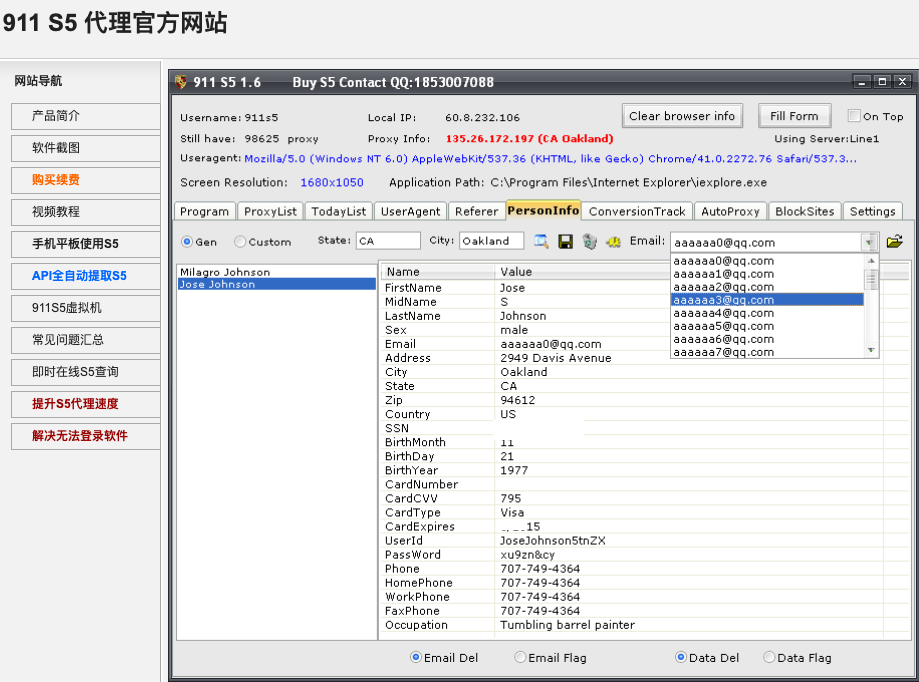
The 911 user interface, as it existed when the service first launched in 2016.
A review of the clues left behind by 911’s early days on the Internet paint a more complete picture of this long-running proxy network. The domain names used by 911 over the years have a few common elements in their original WHOIS registration records, including the address ustraffic@qq.com and a Yunhe Wang from Beijing.
That ustraffic email is tied to a small number of interesting domains, including browsingguard[.]com, cleantraffic[.]net, execlean[.]net, proxygate[.]net, and flashupdate[.]net.
A cached copy of flashupdate[.]net available at the Wayback Machine shows that in 2016 this domain was used for the “ExE Bucks” affiliate program, a pay-per-install business which catered to people already running large collections of hacked computers or compromised websites. Affiliates were paid a set amount for each installation of the software, with higher commissions for installs in more desirable nations, particularly Europe, Canada and the United States.
“We load only one software — it’s a Socks5 proxy program,” read the message to ExE Bucks affiliates. The website said affiliates were free to spread the proxy software by any means available (i.e. “all promotion methods allowed”). The website’s copyright suggests the ExE Bucks affiliate program dates back to 2012.

A cached copy of flashupdate[.]net circa 2016, which shows it was the home of a pay-per-install affiliate program that incentivized the silent installation of its software. “FUD” in the ad above refers to software and download links that are “Fully UnDetectable” as suspicious or malicious by all antivirus software.
Another domain tied to the ustraffic@qq.com email in 2016 was ExeClean[.]net, a service that advertised to cybercriminals seeking to obfuscate their malicious software so that it goes undetected by all or at least most of the major antivirus products on the market.
“Our technology ensures the maximum security from reverse engineering and antivirus detections,” ExEClean promised.
Yet another domain connected to the ustraffic email is p2pshare[.]net, which advertised “free unlimited internet file-sharing platform” for those who agreed to install their software.
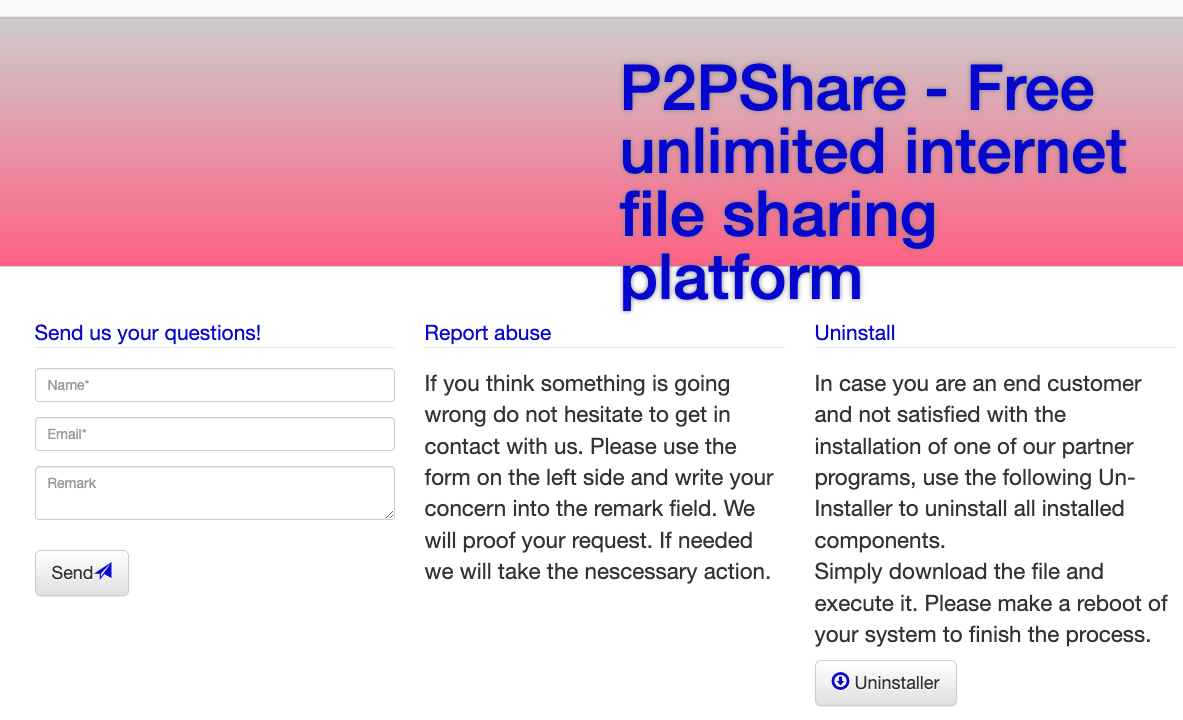
p2pshare.net, which bundled 911 proxy with an application that promised access to free unlimited internet file-sharing.
Still more domains associated with ustraffic@qq.com suggest 911’s proxy has been disguised as security updates for video player plugins, including flashplayerupdate[.]xyz, mediaplayerupdate[.]xyz, and videoplayerupdate[.]xyz.
The earliest version of the 911 website available from the Wayback Machine is from 2016. A sister service called proxygate[.]net launched roughly a year prior to 911 as a “free” public test of the budding new residential proxy service. “Basically using clients to route for everyone,” was how Proxygate described itself in 2016.
For more than a year after its founding, the 911 website was written entirely in Simplified Chinese. The service has only ever accepted payment via virtual currencies such as Bitcoin and Monero, as well as Alipay and China UnionPay, both payment platforms based in China.
Initially, the terms and conditions of 911’s “End User License Agreement (EULA) named a company called Wugaa Enterprises LLC, which was registered in California in 2016. Records from the California Secretary of State office show that in November 2016, Wugaa Enterprises said it was in the Internet advertising business, and had named as its CEO as one Nicolae Aurelian Mazgarean of Brasov, Romania.
A search of European VAT numbers shows the same Brasov, RO address tied to an enterprise called PPC Leads SRL (in the context of affiliate-based marketing, “PPC” generally refers to the term “pay-per-click”).
911’s EULA would later change its company name and address in 2017, to International Media Ltd. in the British Virgin Islands. That is the same information currently displayed on the 911 website.
The EULA attached to 911 software downloaded from browsingguard[.]com (tied to the same ustraffic@qq email that registered 911) references a company called Gold Click Limited. According to the UK Companies House, Gold Click Limited was registered in 2016 to a 34-year-old Yunhe Wang from Beijing City. Many of the WHOIS records for the above mentioned domains also include the name Yunhe Wang, or some variation thereof.
In a response to questions from KrebsOnSecurity, 911 said the researchers were wrong, and that 911 has nothing to do with any of the other domains mentioned above.
“We have 911 SDK link and how it works described clearly in the “Terms of use” of affiliated partners products, and we have details of how the community powered network works on our webpages,” read an email response.
“Besides that, for protecting the end users, we banned many domains’ access and blocked the vulnerable ports, e.g. spamming emails, and torrent is not possible from the 911 network,” the reply continued. “Same as scanning and many others…Accessing to the Lan network and router is also blocked. We are monitoring 911 user’s account closely, once any abnormal behavior detected, we suspend the user’s account right away.”
911 has remained one of the most popular services among denizens of the cybercrime underground for years, becoming almost shorthand for connecting to that “last mile” of cybercrime. Namely, the ability to route one’s malicious traffic through a computer that is geographically close to the consumer whose credit card they’re about to charge at some website, or whose bank account they’re about to empty.
Given the frequency with which 911 has been praised by cybercrooks on the top forums, it was odd to find the proprietors of 911 do not appear to have created any official support account for the service on any of several dozen forums reviewed by this author going back a decade. However there are two cybercriminal identities on the forums that have responded to individual 911 help requests, and who promoted the sale of 911 accounts via their handles.
Both of these identities were active on the crime forum fl.l33t[.]su between 2016 and 2019. The user “Transfer” advertised and sold access to 911 from 2016 to 2018, amid many sales threads where they advertised expensive electronics and other consumer goods that were bought online with stolen credit cards.
In a 2017 discussion on fl.l33t[.]su, the user who picked the handle “527865713” could be seen answering private messages in response to help inquiries seeking someone at 911. That identity is tied to an individual who for years advertised the ability to receive and relay large wire transfers from China.
One ad from this user in 2016 offered a “China wire service” focusing on Western Union payments, where “all transfers are accepted in China.” The service charged 20 percent of all “scam wires,” unauthorized wire transfers resulting from bank account takeovers or scams like CEO impersonation schemes.
In August 2021, 911’s biggest competitor — a 15-year-old proxy network built on malware-compromised PCs called VIP72 — abruptly closed up shop. Almost overnight, an overwhelming number of former VIP72 customers began shifting their proxy activities to 911.

The login page for VIP72, until recently 911’s largest competitor.
That’s according to Riley Kilmer, co-founder of Spur.us — a security company that monitors anonymity services. Kilmer said 911 also gained an influx of new customers after the Jan. 2022 closure of LuxSocks, another malware-based proxy network.
“911’s user base skyrocketed after VIP72 and then LuxSocks went away,” Kilmer said. “And it’s not hard to see why. 911 and VIP72 are both Windows-based apps that operate in a similar way, where you buy private access to IPs.”
Kilmer said 911 is interesting because it appears to be based in China, while nearly all of the other major proxy networks are Russian-backed or Russian-based.
“They have two basic methods to get new IPs,” Kilmer said. “The free VPN apps, and the other is trojanized torrents. They’ll re-upload Photoshop and stuff like that so that it’s backdoored with the 911 proxy. They claim the proxy is bundled with legitimate software and that users all agree to their Terms of Service, meanwhile they can hide behind the claim that it was some affiliate who installed the software, not them.”
Kilmer said at last count, 911 had nearly 200,000 proxy nodes for sale, spanning more than 200 countries: The largest geographic concentration is the United States, where more than 42,000 proxies are currently for rent by the service.
Beware of “free” or super low-cost VPN services. Proper VPN services are not cheap to operate, so the revenue for the service has to come from somewhere. And there are countless “free” VPN services that are anything but, as we’ve seen with 911.
In general, the rule of thumb for transacting online is that if you’re not the paying customer, then you and/or your devices are probably the product that’s being sold to others. Many free VPN services will enlist users as VPN nodes for others to use, and some even offset costs by collecting and reselling data from their users.
All VPN providers claim to prioritize the privacy of their users, but many then go on to collect and store all manner of personal and financial data from those customers. Others are fairly opaque about their data collection and retention policies.
I’ve largely avoided wading into the fray about which VPN services are best, but there are so many shady and just plain bad ones out there that I’d be remiss if I didn’t mention one VPN provider whose business practices and transparency of operation consistently distinguish them from the rest. If maintaining your privacy and anonymity are primary concerns for you as a VPN user, check out Mullvad.net.
Let me make clear that KrebsOnSecurity does not have any financial or business ties to this company (for the avoidance of doubt, this post doesn’t even link to them). I mention it only because I’ve long been impressed with their candor and openness, and because Mullvad goes out of its way to discourage customers from sharing personal or financial data.
To that end, Mullvad will even accept mailed payments of cash to fund accounts, quite a rarity these days. More importantly, the service doesn’t ask users to share phone numbers, email addresses or any other personal information. Nor does it require customers to create passwords: Each subscription can be activated just by entering a Mullvad account number (woe to those who lose their account number).
I wish more companies would observe this remarkably economical security practice, which boils down to the mantra, “You don’t have to protect what you don’t collect.”
Update, July 24, 11:15 a.m. ET: 911’s homepage now includes a banner saying the service has halted new registrations and payments. “We are reviewing our network and adding a series of security measures to prevent misuse of our services,” the message reads. “Proxy balance top-up and new user registration are closed. We are reviewing every existing user, to ensure their usage is legit and [in] compliance with our Terms of Service.”
Update, July 30, 10:07 a.m. ET: 911 announced on July 28 that it is permanently closing down, following a series of data breaches this month that 911 says resulted in the deletion of customer data.






Microsoft today released updates to fix at least 86 security vulnerabilities in its Windows operating systems and other software, including a weakness in all supported versions of Windows that Microsoft warns is actively being exploited. The software giant also has made a controversial decision to put the brakes on a plan to block macros in Office documents downloaded from the Internet.

In February, security experts hailed Microsoft’s decision to block VBA macros in all documents downloaded from the Internet. The company said it would roll out the changes in stages between April and June 2022.
Macros have long been a trusted way for cybercrooks to trick people into running malicious code. Microsoft Office by default warns users that enabling macros in untrusted documents is a security risk, but those warnings can be easily disabled with the click of button. Under Microsoft’s plan, the new warnings provided no such way to enable the macros.
As Ars Technica veteran reporter Dan Goodin put it, “security professionals—some who have spent the past two decades watching clients and employees get infected with ransomware, wipers, and espionage with frustrating regularity—cheered the change.”
But last week, Microsoft abruptly changed course. As first reported by BleepingComputer, Redmond said it would roll back the changes based on feedback from users.
“While Microsoft has not shared the negative feedback that led to the rollback of this change, users have reported that they are unable to find the Unblock button to remove the Mark-of-the-Web from downloaded files, making it impossible to enable macros,” Bleeping’s Sergiu Gatlan wrote.
Microsoft later said the decision to roll back turning off macros by default was temporary, although it has not indicated when this important change might be made for good.
The zero-day Windows vulnerability already seeing active attacks is CVE-2022-22047, which is an elevation of privilege vulnerability in all supported versions of Windows. Trend Micro’s Zero Day Initiative notes that while this bug is listed as being under active attack, there’s no information from Microsoft on where or how widely it is being exploited.
“The vulnerability allows an attacker to execute code as SYSTEM, provided they can execute other code on the target,” ZDI’s Dustin Childs wrote. “Bugs of this type are typically paired with a code execution bug, usually a specially crafted Office or Adobe document, to take over a system. These attacks often rely on macros, which is why so many were disheartened to hear Microsoft’s delay in blocking all Office macros by default.”
Kevin Breen, director of cyber threat research at Immersive Labs, said CVE-2022-22047 is the kind of vulnerability that is typically seen abused after a target has already been compromised.
“Crucially, it allows the attacker to escalate their permissions from that of a normal user to the same permissions as the SYSTEM,” he said. “With this level of access, the attackers are able to disable local services such as Endpoint Detection and Security tools. With SYSTEM access they can also deploy tools like Mimikatz which can be used to recover even more admin and domain level accounts, spreading the threat quickly.”
After a brief reprieve from patching serious security problems in the Windows Print Spooler service, we are back to business as usual. July’s patch batch contains fixes for four separate elevation of privilege vulnerabilities in Windows Print Spooler, identified as CVE-2022-22022, CVE-2022-22041, CVE-2022-30206, and CVE-2022-30226. Experts at security firm Tenable note that these four flaws provide attackers with the ability to delete files or gain SYSTEM level privileges on a vulnerable system.
Roughly a third of the patches issued today involve weaknesses in Microsoft’s Azure Site Recovery offering. Other components seeing updates this month include Microsoft Defender for Endpoint; Microsoft Edge (Chromium-based); Office; Windows BitLocker; Windows Hyper-V; Skype for Business and Microsoft Lync; and Xbox.
Four of the flaws fixed this month address vulnerabilities Microsoft rates “critical,” meaning they could be used by malware or malcontents to assume remote control over unpatched Windows systems, usually without any help from users. CVE-2022-22029 and CVE-2022-22039 affect Network File System (NFS) servers, and CVE-2022-22038 affects the Remote Procedure Call (RPC) runtime.
“Although all three of these will be relatively tricky for attackers to exploit due to the amount of sustained data that needs to be transmitted, administrators should patch sooner rather than later,” said Greg Wiseman, product manager at Rapid7. “CVE-2022-30221 supposedly affects the Windows Graphics Component, though Microsoft’s FAQ indicates that exploitation requires users to access a malicious RDP server.”
Separately, Adobe today issued patches to address at least 27 vulnerabilities across multiple products, including Acrobat and Reader, Photoshop, RoboHelp, and Adobe Character Animator.
For a closer look at the patches released by Microsoft today and indexed by severity and other metrics, check out the always-useful Patch Tuesday roundup from the SANS Internet Storm Center. And it’s not a bad idea to hold off updating for a few days until Microsoft works out any kinks in the updates: AskWoody.com usually has the lowdown on any patches that may be causing problems for Windows users.
As always, please consider backing up your system or at least your important documents and data before applying system updates. And if you run into any problems with these updates, please drop a note about it here in the comments.
Twice in the past month KrebsOnSecurity has heard from readers who had their accounts at big-three credit bureau Experian hacked and updated with a new email address that wasn’t theirs. In both cases the readers used password managers to select strong, unique passwords for their Experian accounts. Research suggests identity thieves were able to hijack the accounts simply by signing up for new accounts at Experian using the victim’s personal information and a different email address.

John Turner is a software engineer based in Salt Lake City. Turner said he created the account at Experian in 2020 to place a security freeze on his credit file, and that he used a password manager to select and store a strong, unique password for his Experian account.
Turner said that in early June 2022 he received an email from Experian saying the email address on his account had been changed. Experian’s password reset process was useless at that point because any password reset links would be sent to the new (impostor’s) email address.
An Experian support person Turner reached via phone after a lengthy hold time asked for his Social Security Number (SSN) and date of birth, as well as his account PIN and answers to his secret questions. But the PIN and secret questions had already been changed by whoever re-signed up as him at Experian.
“I was able to answer the credit report questions successfully, which authenticated me to their system,” Turner said. “At that point, the representative read me the current stored security questions and PIN, and they were definitely not things I would have used.”
Turner said he was able to regain control over his Experian account by creating a new account. But now he’s wondering what else he could do to prevent another account compromise.
“The most frustrating part of this whole thing is that I received multiple ‘here’s your login information’ emails later that I attributed to the original attackers coming back and attempting to use the ‘forgot email/username’ flow, likely using my SSN and DOB, but it didn’t go to their email that they were expecting,” Turner said. “Given that Experian doesn’t support two-factor authentication of any kind — and that I don’t know how they were able to get access to my account in the first place — I’ve felt very helpless ever since.”
Arthur Rishi is a musician and co-executive director of the Boston Landmarks Orchestra. Rishi said he recently discovered his Experian account had been hijacked after receiving an alert from his credit monitoring service (not Experian’s) that someone had tried to open an account in his name at JPMorgan Chase.
Rishi said the alert surprised him because his credit file at Experian was frozen at the time, and Experian did not notify him about any activity on his account. Rishi said Chase agreed to cancel the unauthorized account application, and even rescinded its credit inquiry (each credit pull can ding your credit score slightly).
But he never could get anyone from Experian’s support to answer the phone, despite spending what seemed like eternity trying to progress through the company’s phone-based system. That’s when Rishi decided to see if he could create a new account for himself at Experian.
“I was able to open a new account at Experian starting from scratch, using my SSN, date of birth and answering some really basic questions, like what kind of car did you take out a loan for, or what city did you used to live in,’ Rishi said.
Upon completing the sign-up, Rishi noticed that his credit was unfrozen.
Like Turner, Rishi is now worried that identity thieves will just hijack his Experian account once more, and that there is nothing he can do to prevent such a scenario. For now, Rishi has decided to pay Experian $25.99 a month to more closely monitor his account for suspicious activity. Even using the paid Experian service, there were no additional multi-factor authentication options available, although he said Experian did send a one-time code to his phone via SMS recently when he logged on.
“Experian now sometimes does require MFA for me if I use a new browser or have my VPN on,” Rishi said, but he’s not sure if Experian’s free service would have operated differently.
“I get so angry when I think about all this,” he said. “I have no confidence this won’t happen again.”
In a written statement, Experian suggested that what happened to Rishi and Turner was not a normal occurrence, and that its security and identity verification practices extend beyond what is visible to the user.
“We believe these are isolated incidents of fraud using stolen consumer information,” Experian’s statement reads. “Specific to your question, once an Experian account is created, if someone attempts to create a second Experian account, our systems will notify the original email on file.”
“We go beyond reliance on personally identifiable information (PII) or a consumer’s ability to answer knowledge-based authentication questions to access our systems,” the statement continues. “We do not disclose additional processes for obvious security reasons; however, our data and analytical capabilities verify identity elements across multiple data sources and are not visible to the consumer. This is designed to create a more positive experience for our consumers and to provide additional layers of protection. We take consumer privacy and security seriously, and we continually review our security processes to guard against constant and evolving threats posed by fraudsters.”
KrebsOnSecurity sought to replicate Turner and Rishi’s experience — to see if Experian would allow me to re-create my account using my personal information but a different email address. The experiment was done from a different computer and Internet address than the one that created the original account years ago.
After providing my Social Security Number (SSN), date of birth, and answering several multiple choice questions whose answers are derived almost entirely from public records, Experian promptly changed the email address associated with my credit file. It did so without first confirming that new email address could respond to messages, or that the previous email address approved the change.
Experian’s system then sent an automated message to the original email address on file, saying the account’s email address had been changed. The only recourse Experian offered in the alert was to sign in, or send an email to an Experian inbox that replies with the message, “this email address is no longer monitored.”

After that, Experian prompted me to select new secret questions and answers, as well as a new account PIN — effectively erasing the account’s previously chosen PIN and recovery questions. Once I’d changed the PIN and security questions, Experian’s site helpfully reminded me that I have a security freeze on file, and would I like to remove or temporarily lift the security freeze?
To be clear, Experian does have a business unit that sells one-time password services to businesses. While Experian’s system did ask for a mobile number when I signed up a second time, at no time did that number receive a notification from Experian. Also, I could see no option in my account to enable multi-factor authentication for all logins.
How does Experian differ from the practices of Equifax and TransUnion, the other two big consumer credit reporting bureaus? When KrebsOnSecurity tried to re-create an existing account at TransUnion using my Social Security number, TransUnion rejected the application, noting that I already had an account and prompting me to proceed through its lost password flow. The company also appears to send an email to the address on file asking to validate account changes.
Likewise, trying to recreate an existing account at Equifax using personal information tied to my existing account prompts Equifax’s systems to report that I already have an account, and to use their password reset process (which involves sending a verification email to the address on file).
KrebsOnSecurity has long urged readers in the United States to place a security freeze on their files with the three major credit bureaus. With a freeze in place, potential creditors can’t pull your credit file, which makes it very unlikely anyone will be granted new lines of credit in your name. I’ve also advised readers to plant their flag at the three major bureaus, to prevent identity thieves from creating an account for you and assuming control over your identity.
The experiences of Rishi, Turner and this author suggest Experian’s practices currently undermine both of those proactive security measures. Even so, having an active account at Experian may be the only way you find out when crooks have assumed your identity. Because at least then you should receive an email from Experian saying they gave your identity to someone else.
In April 2021, KrebsOnSecurity revealed how identity thieves were exploiting lax authentication on Experian’s PIN retrieval page to unfreeze consumer credit files. In those cases, Experian failed to send any notice via email when a freeze PIN was retrieved, nor did it require the PIN to be sent to an email address already associated with the consumer’s account.
A few days after that April 2021 story, KrebsOnSecurity broke the news that an Experian API was exposing the credit scores of most Americans.
Emory Roan, policy counsel for the Privacy Rights Clearinghouse, said Experian not offering multi-factor authentication for consumer accounts is inexcusable in 2022.
“They compound the problem by gating the recovery process with information that’s likely available or inferable from third party data brokers, or that could have been exposed in previous data breaches,” Roan said. “Experian is one of the largest Consumer Reporting Agencies in the country, trusted as one of the few essential players in a credit system Americans are forced to be part of. For them to not offer consumers some form of (free) MFA is baffling and reflects extremely poorly on Experian.”
Nicholas Weaver, a researcher for the International Computer Science Institute at University of California, Berkeley, said Experian has no real incentive to do things right on the consumer side of its business. That is, he said, unless Experian’s customers — banks and other lenders — choose to vote with their feet because too many people with frozen credit files are having to deal with unauthorized applications for new credit.
“The actual customers of the credit service don’t realize how much worse Experian is, and this isn’t the first time Experian has screwed up horribly,” Weaver said. “Experian is part of a triopoly, and I’m sure this is costing their actual customers money, because if you have a credit freeze that gets lifted and somebody loans against it, it’s the lender who eats that fraud cost.”
And unlike consumers, he said, lenders do have a choice in which of the triopoly handles their credit checks.
“I do think it’s important to point out that their real customers do have a choice, and they should switch to TransUnion and Equifax,” he added.
More greatest hits from Experian:
2017: Experian Site Can Give Anyone Your Credit Freeze PIN
2015: Experian Breach Affects 15 Million Customers
2015: Experian Breach Tied to NY-NJ ID Theft Ring
2015: At Experian, Security Attrition Amid Acquisitions
2015: Experian Hit With Class Action Over ID Theft Service
2014: Experian Lapse Allowed ID Theft Service Access to 200 Million Consumer Records
2013: Experian Sold Consumer Data to ID Theft Service
Update, 10:32 a.m.: Updated the story to clarify that while Experian does sometimes ask users to enter a one-time code sent via SMS to the number on file, there does not appear to be any option to enable this on all logins.







In the spirit of #PrideMonth, McAfee hosted month-long celebrations across the world. One of these was a live event hosted by the McAfee Pride Community with a guest speaker from the Resource Center that focused on the history of Pride, support, allyship, and belonging.
We took a moment to ask our event guest speaker, Leslie McMurray, about the work that Resource Center does, the importance of pride, and what companies can do to create inclusive work environments.
“We like to say, if we had an “elevator pitch”, we would need a really tall building! Resource Center has been around for 39 years and is one of the largest LGBTQIA+ community centers in the United States, it is a primary HIV/AIDS service organization in Texas.
Some of the work that we do includes operating a food pantry and hot meal program that serves low-income people living with HIV. We have a case management department that helps locate resources that we don’t directly provide, like housing. And we have a primary care clinic that is gender-affirming and a ten-chair dental clinic that also serves those living with HIV.
We also have a youth program called Youth First that serves youth from middle-to-high school. We have a behavioral health program and a clinic that does free testing for HIV and STDs along with a mobile health unit that does free testing in outlying areas. Finally, our advocacy department has three full-time employees!
“Sometimes we get asked “What’s ‘Pride’ about? Why do you need a parade?”
It’s important to understand that LGBTQIA+ people are still working to achieve equal rights – the same as everyone else.
The tipping point of the fight for equal rights in the US dates back to 1969 when the Stonewall Uprising took place in Manhattan. The first Pride march was held a year later to honor the anniversary of the Stonewall Uprising and continues to take place during the month of June each year. And while we appreciate the attention during the month, the continued fight for equal rights for the LGBTQIA+ community is yearly, and we need continuous support and allyship of people and businesses year-round.
So it’s really important for people to learn about diverse populations, understand what their challenges are, and educate yourself on these issues – from that spring’s allies.”
“One of the simplest things for companies to do is to include ‘Sexual Orientation, Gender Identity and Gender expression’ in your Equal Employment Opportunity statement. Other things companies can do is to look at putting a policy in place for transgender employees who are transitioning and consider including transgender healthcare in your company benefits package.
Make sure to help foster understanding by getting employees to do training with organizations like Resource Center. And empower upper management to lead the way ensuring all employees can bring their whole selves to work. Finally, when the opportunity arises look at working with and bringing in non-profit organizations into your company to continue spreading awareness and support for the LGBTQIA+ community.
And while June wraps up Pride month, year-round we work towards a workplace and community where all can belong – a workplace where our unique differences are celebrated and where we all stand together for equality. #McAfeePride
Learn more about the incredible work that Resource Center does here
Interested in building your career at a company where you can belong? Search our openings!
The post #McAfeePride2022 appeared first on McAfee Blog.














The past few months have been chockfull of conversations with security customers, partners, and industry leaders. After two years of virtual engagements, in-person events like our CISO Forum and Cisco Live as well as the industry’s RSA Conference underscore the power of face-to-face interactions. It’s a reminder of just how enriching conversations are and how incredibly interconnected the world is. And it’s only made closer by the security experiences that impact us all.
I had the pleasure of engaging with some of the industry’s best and brightest, sharing ideas, insights, and what keeps us up at night. The conversations offered more than an opportunity to reconnect and put faces with names. It was a chance to discuss some of the most critical cybersecurity issues and implications that are top of mind for organizations.
The collective sentiments are clear. The need for better security has never been so strong. Securing the future is good business. Disruptions are happening faster than ever before, making our interconnected world more unpredictable. Hybrid work is here to stay, hybrid and complex architectures will continue to be a reality for most organizations and that has dramatically expanded the threat surface. More and more businesses are operating as ecosystems—attacks have profound ripple effects across value chains. Attacks are becoming more bespoke, government-sponsored threat actors and ransomware as a service, continue to unravel challenging businesses to minimize the time from initial breach to complete compromise, in the event of a compromise.
Regardless of where organizations are on their digital transformations, they are progressively embarking upon journeys to unify networking and secure connectivity needs. Mobility, BYOD (bring your own device), cloud, increased collaboration, and the consumerization of IT have necessitated a new type of access control security–zero trust security. Supporting a modern enterprise across a distributed network and infrastructure involves the ability to validate user IDs, continuously verify authentication and device trust, and protect every application—
without compromising user experience. Zero trust offers organizations a simpler approach to securing access for everyone, from any device, anywhere—all the while, making it harder for attackers.
Simplicity continues to be a hot topic, and in the context of its functionality. In addition to a frictionless user experience, the real value to customers is improving operational challenges. Security practitioners want an easier way to secure the edge, access, and operations—including threat intelligence and response. Key to this simplified experience is connecting and managing business-critical control points and vulnerabilities, exchanging data, and contextualizing threat intelligence. And it requires a smarter ecosystem that brings together capabilities, unifying admin, policy, visibility, and control. Simplicity that works hard and smart—and enhances their security posture. The ultimate simplicity is improved efficacy for the organization.
Insider cyber-attacks are among the fastest growing threats in the modern security network, an increasingly common cause of data breaches. Using their authorized access, employees are intentionally or inadvertently causing harm by stealing, exposing, or destroying sensitive company data. Regardless, the consequences are the same—costing companies big bucks and massive disruption. It’s also one of the reasons why “identity as the new perimeter” is trending, as the primary objective of all advanced attacks is to gain privileged credentials. Insider attack attempts are not slowing down. However, advanced telemetry, threat detection and protection, and continuous trusted access all help decelerate the trend. Organizations are better able to expose suspicious or malicious activities caused by insider threats. Innovations are enabling business to analyze all network traffic and historical patterns of employee access and determine whether to let an employee continue uninterrupted or prompt to authenticate again.
Supply chain attacks have become one of the biggest security worries for businesses. Not only are disruptions debilitating, but no one knew the impacts or perceived outcomes. Attackers are highly aware that supply chains are comprised of larger entities often tightly connected to a broad array of smaller and less cyber-savvy organizations. Lured by lucrative payouts, attackers seek the weakest supply chain link for a successful breach. In fact, two of the four biggest cyber-attacks that the Cisco Talos team saw in the field last year were supply chain attacks that deployed ransomware on their targets’ networks: SolarWinds and REvil’s attack exploiting the Kaseya managed service provider. While there’s no perfect way to absolutely protect from ransomware, businesses are taking steps to bolster their defenses and protect against disaster.
Security incidents targeting personal information are on the rise. In fact, 86 percent of global consumers were victims of identity theft, credit/debit card fraud, or a data breach in 2020. In a recent engagement discovered by the Cisco Talos team, the API on a customer’s website could have been exploited by an attacker to steal sensitive personal information. The good news is governments and businesses alike are leaning into Data Privacy and Protection, adhering to global regulations that enforce high standards for collecting, using, disclosing, storing, securing, accessing, transferring, and processing personal data. Within the past year, the U.S. government implemented new rules to ensure companies and federal agencies follow required cybersecurity standards. As long as cyber criminals continue seeking to breach our privacy and data, these rules help hold us accountable.
Through all the insightful discussions with customers, partners, and industry leaders, a theme emerged. When it comes to cybersecurity, preparation is key and the cost of being wrong is extraordinary. By acknowledging there will continue to be disruptions, business can prepare for whatever comes next. And when it comes, they’ll not only weather the storm, but they will also come out of it stronger. And the good news is that Cisco Security Business Group is already on the journey actively addressing these headlines, and empowering our customers to reach their full potential, securely.
We’d love to hear what you think. Ask a Question, Comment Below, and Stay Connected with Cisco Secure on social!
Cisco Secure Social Channels
What is it that customers truly want from their security? Is it simplicity? Robust protection? Agility and flexibility? Yes! In today’s uncertain world where new challenges are being thrown at IT teams each day, security must meet many diverse needs. At the end of the day, it’s about keeping the entire business resilient despite the chaos of the cyber world.
As hybrid work, the move to the cloud, and increasingly insidious threats all converge to create layers of complexity, security teams must be extra vigilant and ready for what’s next. They need a comprehensive, integrated security system whose various components share information and work together to pinpoint attacks and minimize organizational impact — without introducing undue friction.
With businesses, networks, clouds and devices becoming so interconnected, delivering next-level security to match the future of work is a formidable undertaking — one that few vendors are positioned to tackle. But thanks to our nearly 40-year heritage of providing and protecting a vast amount of the world’s networking infrastructure, Cisco is up for the challenge.
“At a moment’s notice, we were able to transition 80 percent of our workforce to be remote — and our company was never remote before. Because of our Cisco solutions, we were able to deploy everything and have people work well remotely with very minimal issues.”
— Joseph Rodriguez, Assistant Director of IT, Allied Beverage Group
Delivering security that is simple, powerful and resilient is something we’ve been executing on for years, yet it’s never been more critical than it is at this very moment. The month of June has afforded us the perfect opportunity to showcase exactly how we plan to keep our customers cyber resilient both now and in the future.
Read about the five dimensions of security resilience.
During the RSA Conference and Cisco Live, we announced our strategic plan for the Cisco Security Cloud, a global, cloud-delivered, integrated platform that secures and connects organizations of any shape and size. As we continue to move towards the Cisco Security Cloud vision, we recently unveiled several advancements in our portfolio across SASE, XDR and zero trust.
You can read our news announcement to learn more about security resilience and how we’re delivering it. But more important than the ‘how’ is the ‘why.’ Why Cisco? What makes us uniquely positioned to secure your resilience?
As I mentioned, our customers have trusted us with their networks for nearly four decades. Currently, 80 percent of the world’s internet traffic travels through Cisco infrastructure — so we have a pretty good handle on what’s going on out there. From a security standpoint alone, we have over 300,000 customers around the globe, including 100% of the Fortune 100.
As a leader in both networking and security, the breadth and depth of our solutions is unmatched. While other vendors are just beginning to join networking with security, we’ve been doing it for years. And yet, we’re continually finding ways to simplify our robust solutions for a streamlined user experience — no matter the size of your organization, where your employees work, or whether your applications are on-premises, in the cloud, or both.
Learn more about security resilience for the hybrid work era.
In addition to unparalleled infrastructure and expertise, our open, cloud-native architecture allows you to integrate with a wide range of third-party security and technology solutions for more seamless threat defense. This includes the major cloud vendors, enabling you to secure a multi-cloud environment without getting locked in with just one public cloud provider.
Additionally, all of our solutions are backed by Cisco Talos, one of the largest commercial threat intelligence teams in the world. Combined with in-depth visibility from our Cisco Secure technologies, Talos’ extensive insight into the threat landscape leads to rapid, highly effective detection and response.
Even more crucial than what we have to say is what we have heard from our customers surrounding the “new normal” for security. “I think what the security industry could use right now is a real business outcome-oriented viewpoint,” said Tom Doughty, vice president and CISO at Prudential Financial. “Meaning, what are the strategic business outcomes you’re trying to enable? Cisco can help security teams be more aligned to our business and more resilient by allowing us to see at a granular level what’s happening in our environment, especially in an extended network.”
For the law firm of George Sink, P.A., the demands of supporting hybrid work accelerated the company’s move to the cloud. The firm is now using Cisco’s new, turnkey SASE solution to securely serve its clients under any circumstance — be it a pandemic or a hurricane. According to the firm’s CIO, Timothy Mullen, “The ability to…re-establish connectivity in another region almost immediately, with my small IT team, is unheard of and a game-changing experience.”
From financial to legal transactions, and much more, we can secure it all with our open, integrated protection platform and unwavering focus on resilience. We even had the honor of securing the Super Bowl earlier this year, helping to safeguard mission-critical gameday operations.
“The Super Bowl and events of that magnitude require a humongous orchestration of interconnectedness, not only from a technology perspective but also a people standpoint,” said NFL Chief Information Security Officer, Tomás Maldonado. “What we’re trying to do is slow down the bad actors and make it more difficult for them to attack us and impact what’s happening on the field. But at the same time, we also have to look beyond the field and think about all the various parts of our business that could be affected by an attack — recognizing that our risk factors are always changing.”
To learn more about how to keep your business strong in the face of adversity, visit our resilience web page and check out the blog from Cisco’s Jeetu Patel, “Security Resilience for a Hybrid, Multi-Cloud Future.”
We’d love to hear what you think. Ask a Question, Comment Below, and Stay Connected with Cisco Secure on social!
Cisco Secure Social Channels
On December 7, 2021, Google announced it was suing two Russian men allegedly responsible for operating the Glupteba botnet, a global malware menace that has infected millions of computers over the past decade. That same day, AWM Proxy — a 14-year-old anonymity service that rents hacked PCs to cybercriminals — suddenly went offline. Security experts had long seen a link between Glupteba and AWM Proxy, but new research shows AWM Proxy’s founder is one of the men being sued by Google.
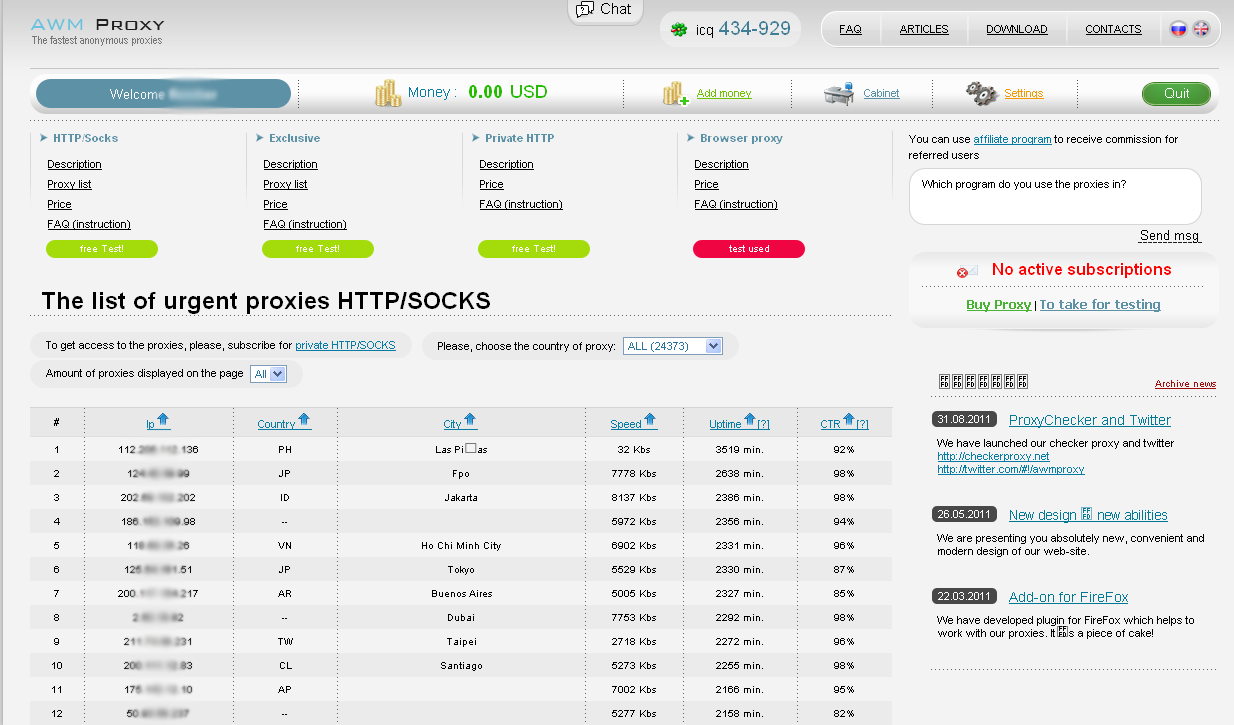
AWMproxy, the storefront for renting access to infected PCs, circa 2011.
Launched in March 2008, AWM Proxy quickly became the largest service for crooks seeking to route their malicious Web traffic through compromised devices. In 2011, researchers at Kaspersky Lab showed that virtually all of the hacked systems for rent at AWM Proxy had been compromised by TDSS (a.k.a TDL-4 and Alureon), a stealthy “rootkit” that installs deep within infected PCs and loads even before the underlying Windows operating system boots up.
In March 2011, security researchers at ESET found TDSS was being used to deploy Glupteba, another rootkit that steals passwords and other access credentials, disables security software, and tries to compromise other devices on the victim’s network — such as Internet routers and media storage servers — for use in relaying spam or other malicious traffic.
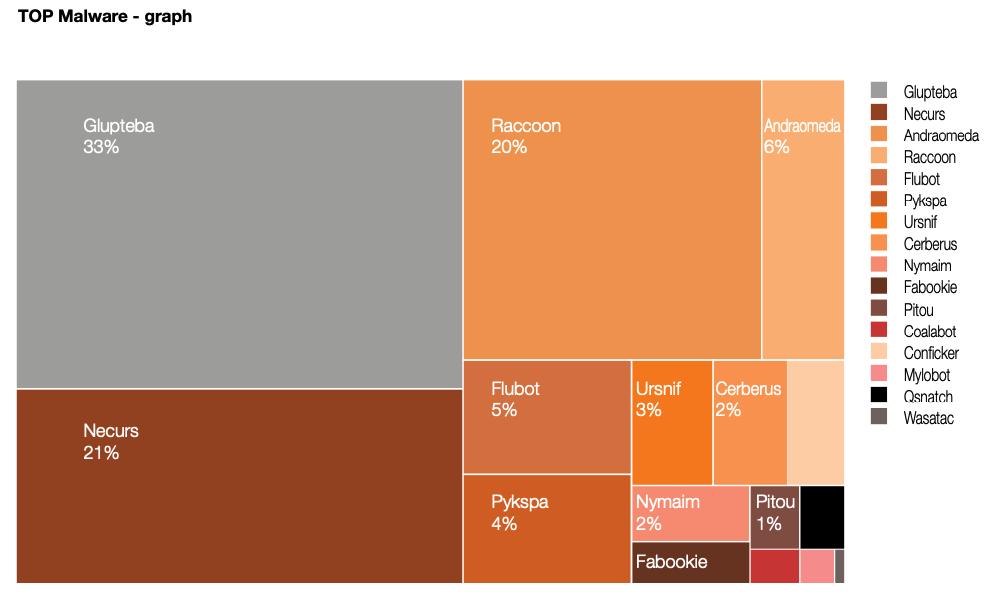
A report from the Polish computer emergency response team (CERT Orange Polksa) found Glupteba was by far the biggest malware threat in 2021.
Like its predecessor TDSS, Glupteba is primarily distributed through “pay-per-install” or PPI networks, and via traffic purchased from traffic distribution systems (TDS). Pay-per-install networks try to match cybercriminals who already have access to large numbers of hacked PCs with other crooks seeking broader distribution of their malware.
In a typical PPI network, clients will submit their malware—a spambot or password-stealing Trojan, for example —to the service, which in turn charges per thousand successful installations, with the price depending on the requested geographic location of the desired victims. One of the most common ways PPI affiliates generate revenue is by secretly bundling the PPI network’s installer with pirated software titles that are widely available for download via the web or from file-sharing networks.

An example of a cracked software download site distributing Glupteba. Image: Google.com.
Over the past decade, both Glupteba and AWM Proxy have grown substantially. When KrebsOnSecurity first covered AWM Proxy in 2011, the service was selling access to roughly 24,000 infected PCs scattered across dozens of countries. Ten years later, AWM Proxy was offering 10 times that number of hacked systems on any given day, and Glupteba had grown to more than one million infected devices worldwide.
There is also ample evidence to suggest that Glupteba may have spawned Meris, a massive botnet of hacked Internet of Things (IoT) devices that surfaced in September 2021 and was responsible for some of the largest and most disruptive distributed denial-of-service (DDoS) attacks the Internet has ever seen.
But on Dec. 7, 2021, Google announced it had taken technical measures to dismantle the Glupteba botnet, and filed a civil lawsuit (PDF) against two Russian men thought to be responsible for operating the vast crime machine. AWM Proxy’s online storefront disappeared that same day.
AWM Proxy quickly alerted its customers that the service had moved to a new domain, with all customer balances, passwords and purchase histories seamlessly ported over to the new home. However, subsequent takedowns targeting AWM Proxy’s domains and other infrastructure have conspired to keep the service on the ropes and frequently switching domains ever since.
Earlier this month, the United States, Germany, the Netherlands and the U.K. dismantled the “RSOCKS” botnet, a competing proxy service that had been in operation since 2014. KrebsOnSecurity has identified the owner of RSOCKS as a 35-year-old from Omsk, Russia who runs the world’s largest forum catering to spammers.

The employees who kept things running for RSOCKS, circa 2016.
Shortly after last week’s story on the RSOCKS founder, I heard from Riley Kilmer, co-founder of Spur.us, a startup that tracks criminal proxy services. Kilmer said RSOCKS was similarly disabled after Google’s combined legal sneak attack and technical takedown targeting Glupteba.
“The RSOCKS website gave you the estimated number of proxies in each of their subscription packages, and that number went down to zero on Dec. 7,” Kilmer said. “It’s not clear if that means the services were operated by the same people, or if they were just using the same sources (i.e., PPI programs) to generate new installations of their malware.”
Kilmer said each time his company tried to determine how many systems RSOCKS had for sale, they found each Internet address being sold by RSOCKS was also present in AWM Proxy’s network. In addition, Kilmer said, the application programming interfaces (APIs) used by both services to keep track of infected systems were virtually identical, once again suggesting strong collaboration.
“One hundred percent of the IPs we got back from RSOCKS we’d already identified in AWM,” Kilmer said. “And the IP port combinations they give you when you access an individual IP were the same as from AWM.”
In 2011, KrebsOnSecurity published an investigation that identified one of the founders of AWM Proxy, but Kilmer’s revelation prompted me to take a fresh look at the origins of this sprawling cybercriminal enterprise to determine if there were additional clues showing more concrete links between RSOCKS, AWM Proxy and Glupteba.
Supporting Kilmer’s theory that AWM Proxy and RSOCKS may simply be using the same PPI networks to spread, further research shows the RSOCKS owner also had an ownership stake in AD1[.]ru, an extremely popular Russian-language pay-per-install network that has been in operation for at least a decade.
Google took aim at Glupteba in part because its owners were using the botnet to divert and steal vast sums in online advertising revenue. So it’s more than a little ironic that the critical piece of evidence linking all of these operations begins with a Google Analytics code included in the HTML code for the original AWM Proxy back in 2008 (UA-3816536).
That analytics code also was present on a handful of other sites over the years, including the now-defunct Russian domain name registrar Domenadom[.]ru, and the website web-site[.]ru, which curiously was a Russian company operating a global real estate appraisal business called American Appraisal.
Two other domains connected to that Google Analytics code — Russian plastics manufacturers techplast[.]ru and tekhplast.ru — also shared a different Google Analytics code (UA-1838317) with web-site[.]ru and with the domain “starovikov[.]ru.”
The name on the WHOIS registration records for the plastics domains is an “Alexander I. Ukraincki,” whose personal information also is included in the domains tpos[.]ru and alphadisplay[.]ru, both apparently manufacturers of point-of-sale payment terminals in Russia.
Constella Intelligence, a security firm that indexes passwords and other personal information exposed in past data breaches, revealed dozens of variations on email addresses used by Alexander I. Ukraincki over the years. Most of those email addresses start with some variation of “uai@” followed by a domain from one of the many Russian email providers (e.g., yandex.ru, mail.ru). [Full disclosure: Constella is currently an advertiser on this website].
But Constella also shows those different email addresses all relied on a handful of passwords — most commonly “2222den” and “2222DEN.” Both of those passwords have been used almost exclusively in the past decade by the person who registered more than a dozen email addresses with the username “dennstr.”
The dennstr identity leads to several variations on the same name — Denis Strelinikov, or Denis Stranatka, from Ukraine, but those clues ultimately led nowhere promising. And maybe that was the point.
Things began looking brighter after I ran a search in DomainTools for web-site[.]ru’s original WHOIS records, which shows it was assigned in 2005 to a “private person” who used the email address lycefer@gmail.com. A search in Constella on that email address says it was used to register nearly two dozen domains, including starovikov.ru and starovikov[.]com.
A cached copy of the contact page for Starovikov[.]com shows that in 2008 it displayed the personal information for a Dmitry Starovikov, who listed his Skype username as “lycefer.”
Finally, Russian incorporation documents show the company LLC Website (web-site[.]ru)was registered in 2005 to two men, one of whom was named Dmitry Sergeevich Starovikov.
Bringing this full circle, Google says Starovikov is one of the two operators of the Glupteba botnet:
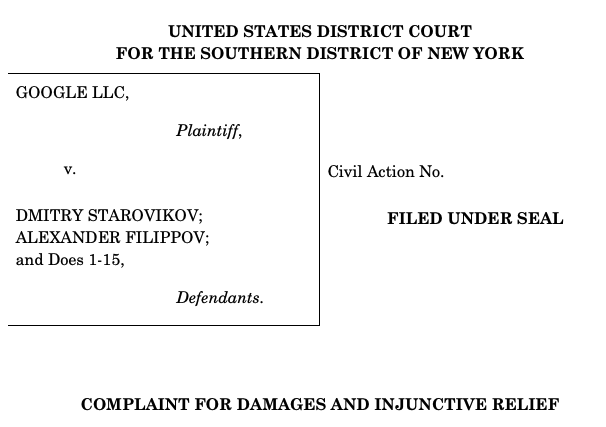
The cover page for Google’s lawsuit against the alleged Glupteba botnet operators.
Mr. Starovikov did not respond to requests for comment. But attorneys for Starovikov and his co-defendant last month filed a response to Google’s complaint in the Southern District of New York, denying (PDF) their clients had any knowledge of the scheme.
Despite all of the disruption caused by Google’s legal and technical meddling, AWM is still around and nearly as healthy as ever, although the service has been branded with a new name and there are dubious claims of new owners. Advertising customer plans ranging from $50 a day to nearly $700 for “VIP access,” AWM Proxy says its malware has been running on approximately 175,000 systems worldwide over the last 24 hours, and that roughly 65,000 of these systems are currently online.
Meanwhile, the administrators of RSOCKS recently alerted customers that the service and any unspent balances will soon be migrated over to a new location.
Many people seem to equate spending time, money and effort to investigate and prosecute cybercriminals with the largely failed war on drugs, meaning there is an endless supply of up-and-coming crooks who will always fill in any gaps in the workforce whenever cybercriminals face justice.
While that may be true for many low-level cyber thieves today, investigations like these show once again how small the cybercriminal underground really is. It also shows how it makes a great deal of sense to focus efforts on targeting and disrupting the relatively small number of established hackers who remain the real force multipliers of cybercrime.








































ruby-1200












